#Blazescompendium
Explore tagged Tumblr posts
Text
Meet Nyami Nyami, new African demon for Shin Megami Tensei V: Vengeance!
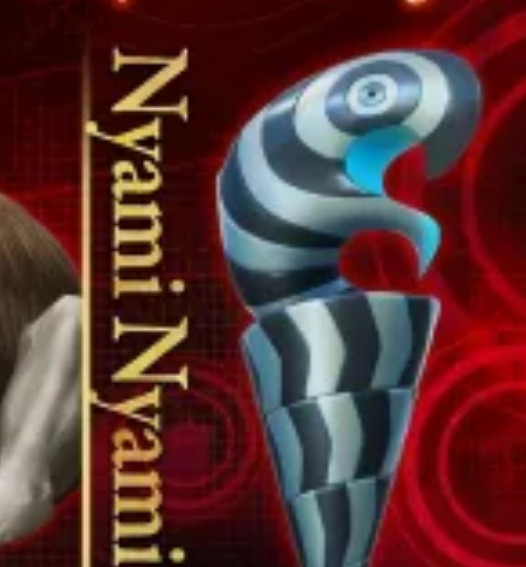
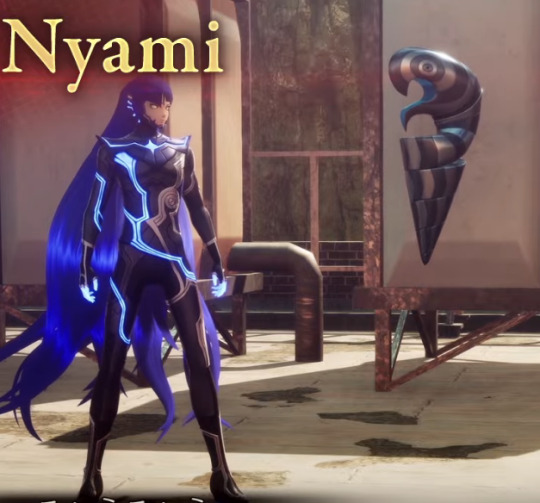
The god of the Zambezi river that flows though the south most part of the African continent. Represented by these statues and wooden carvings along it's path.
Honestly great choice! Doi nailed it in my humble opinion!

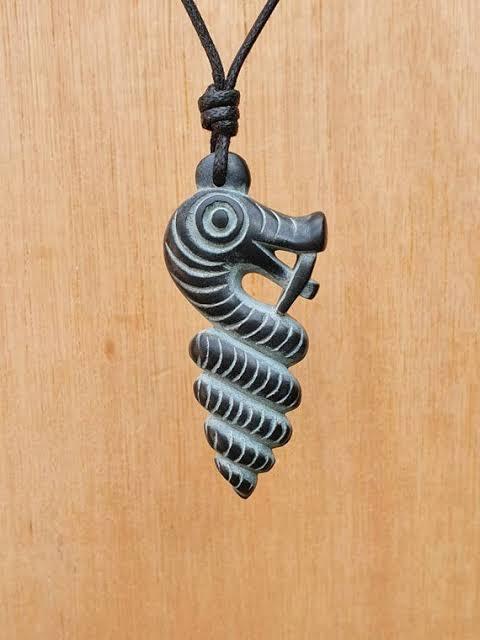
#shin megami tensei#mythology#atlus#blazescompendium#megaten#shin megami tensei v: vengeance#new demon
279 notes
·
View notes
Text
Zhutunshe
If you are looking for a non-Muzuki source of Zhutunshe, Yijianzhi on Wikisource is the way to look up:
有蛇自竹丛出,其长三尺,而大如杵,生四足,遍身有毛,作声如猪,行趋甚疾,为逐人吞噬之势。众皆惊扰,不知所为,适有马槽在侧,急取覆之。而白统制官,遣呼俊。俊至,已能言其状,且名是猪豚蛇,啮人立死。
鄉里亦曾有猪豚蛇,以身腯而短,不能蜿蜒,故惟直前衝人。遭之者無活理。
I am pretty bad of classical Chinese, but the gist of the story of Zhutunshe is that a major Cheng Jun (成俊) who was also a demon expert was order to deal with the monster lurking around garrison which can kill a man with just one bite. It also mentions that the monster appears deep cyan-green (色深青), hence Kaneko���s Zhutunshe colored it like a watermelon.
One side note, the Chinese Wikipedia article about Zhutunshe also cites Muzuki’s book. Not having actually read the source I am not sure if I should remove it.
I really dragged my ass on these asks, but @blazescompendium has the story pretty well covered; you can check it out here.
6 notes
·
View notes
Text
Blaze's Compendium Entry #10: The Khyah (Cyak, Kack, Khya)

Warning: Faith and religion are important real life topics, that tackles the culture and way of life of millions of real life people. It is a cultural expression, and must be respected by all means. Here, we use a video-game ( some times) and other media series only to ignite the flame of learning about the matter, using its art when well depicted, but we do this with all due respect to the cultures we talk here, grounded by real life sources, cultures and people. And i mean this with respect. Hope you all enjoy.
Also, please note that the Sources for this one will be a bit tricky, since we are talking about a regional and always developing urban legend and cosmology, which is not very well documented in traditional books. In this case we have to turn our attention to personal stories and every day people who lives in this culture.
The Khyah (ख्या) is a mythical creature that is part of the greater Nepali folklore and cosmology. Specifically from the Newar people from the Kathmandu Valley.
Some sources will say that its name means literally ''Ghost'' or ''Haunt'', ''Phantasm'', etc... However i was not able to confirm this. The language spoken by Newar people is the Nepal Bhasa, which is also written in the Devanagari script, just like Hindi. I do not speak this language, so please if you do, reach me out! But in any case, it seems that the word for ''Ghost'' in Newar is ''गुफा'' or ''gupha''. It may be the case that the name: ''Kyah'' got so used to general supernatural occurrences, that it got mixed up. Just like we talked about the Saci in my other post. -This is not uncommon to happen- I used regular online translators to reach this conclusion, but feel free to correct me if i am wrong because i could not consult any native to talk about this matter during my research.
For a bit of context, The Newar are people that historically inhabited the Kathmandu Valley, and the regions around Nepal. As we said before, they speak Newari (Nepal Bhasa). They have 3 major cities, those being Kathmandu, Patan and Bhatgaon. [1] The academic research on the Newar people just started at the early 20th century, the french anthropologist Sylvain, wrote a very famous and complete work called Le Nepal, that was one of the first western written works about the region, and its people. Their religion are mostly Hinduism, Buddhism and there are minorities from other beliefs.
The Newar live in this region since ancient times, way longer before Nepal even existed as a Estate. According to most history books, the Newar would live alone in the region, being sovereigns of the Kathmandu valley up until the Gorgkha Kingdom in 1769. It is very hard to know much about the Newar before that in details, since they are in the region for so long, and mixed so much with other people from around the Nepal, that even their history ends up blending with mythology.
For example: according to the sacred Swayambhu Purana, a Buddhist scripture, the Kathmandu Valley was once a huge lake, Inhabited by Nagas*. That is, until one day the Bodhisattva Manjusri with the help of a powerful sacred sword, sliced the surrounding hills, which in turn made the water flow away. This information is even on Kathmandu government official site!
This myth was later confirmed to have a basis, since NASA themselves found out clues that Kathmandu was in fact, once a huge lake. NASA did not reply me about the Naga thought. Bummer...
*The Swayambhu Purana is a Buddhist text essential to Newar Buddhism. However i sadly could not find a copy online, but there are some summarized versions translated to English, which i am using as guide. For instance the US Wikipedia article, sources books that i also could not find, but i could verify the authors! So... That's something, i guess.

This goes to show how the Newar people are rooted in their mythology, and how this is completely absorbed by even their space and surroundings. Even something as the very foundation of their lands is a hierophany.
This brings us to the Kyah, that we will see can show us a lot about this society.
About the Khyah
The Khyah are supernatural creatures that are hairy, looks like apes, sometimes extremely chubby and have their bodies are totally covered in hair. This description is corroborated my multiple sources, like ''Dietrich, Angela (1998). Tantric healing in the Kathmandu Valley: A comparative study of Hindu and Buddhist spiritual healing traditions in urban Nepalese society. Book Faith India.'' But not only that, the Khyah are also represented in multitudes of paintings and also in costumes for the Yenya Festival. The only thing that can sometimes be different, is that if it will be treated like a Ghost or a more physical creature.

The wealth goddess Lakshmi and two Khyah serving her, in a painting on a Kathmandu temple.
About this painting and sourcing the Khyah appearance:
I have made tireless efforts to pin down the origin of this painting. And many others! This one is present in most of the articles about the Khyah in the internet, even local articles from Nepal itself. However i was not able to pinpoint where it came from. All the sources i found either say this is from a ''temple'' or that it was taken by an individual named: Karrattul. This is not the photographer's name, but instead the name of the profile who uploaded it on the Wikipedia, where it was uploaded in 2012! I tried to reach to Nepali communities and other enthusiasts of History and Mythology, but no one could help me. If you know anything about this painting, please contact me!
For the same reason, it is almost impossible to find sourced materials about the khyah appearance. We know that there are traits like the hair, that keep intact from place to place, but i could not find a central work detailing the creature. We have those paintings from so called temples to trust, and the ceremonial suits used in the Khyah dance.
I will link here a video of a Khyah Dance performance, so you can see the physical traits of this creature are well agreed between the locals.
youtube
The Khyah is popular among children, or at least were at one point. This can be seen in a popular children song sang in Nepal. It depicts the Khyah as a cute and hungry little critter, as the kid in the song is encouraged to give food to it. The Kyah seems never to be satisfied sadly...

A banger...
The Khyah is indeed often treated like a type of ghost. In my personal opinion they are simmilar to Djinn, some kinds of yokai and can be classified generically as a type of monster or apparition, in my view at least. (This means a supernatural creature, that is in between a human and a god like being.) The Newar believe that the Khyah has active participation in events of their daily lives. But they also are not all bad or good, they are multiple entities, some good and some bad. Usually there are white colored Khyah who are good, and black colored Khyah who are bad.
They have their own lives, families, and friends. There are a lot of tales and works related to this creature, not counting personal tales of every day people and their encouters with this little devil. That's how ingrained in the Newar culture the Khyah is.
I was able to track the writings of a Kathmandu Valley denizen, which happened to write about the Kyahk! [3] This person was kind enough to provide a lot of personal information about the regional culture, in their personal website. According to the locals, the Khyah would often live in houses, squares, public spaces, and would regularly interfere with their existence. Not all Khyah are bad, some can protect the households they inhabit, they can bring fortune and good luck. Although, the Khyah fears light, so they have to live in dark corners of the house, like the attic or some empty room.
The Unitedstatian Wikipedia page for Khyah shares some unusual information, that we can not trace to any sources. For instance, they mention that this creature supposedly fears electricity. As interesting as it may seen, the source from this particular information goes to a book called: '' Asian folklore studies, Volume 55. Nanzan University Institute of Anthropology'' Which i was unable to find to read online, and was also unable to find it by its ISBN trackers: 9057890984, 9789057890987. Those took me to another book, called: ''Caturmāsa. Celebrations of Death in Kathmandu, Nepal’'
This one seems to exist, but i also could not find it anywhere online. Google Books has some samples, and it guarantees that the word ''Khyak'' or any variations of sorts, are not on it, which means this is a misinformation. Someone probably interpreted that the fact that Khyah fear light, can also apply to electricity as an energy source. I think you won't be letting your homie Khyah uncomfortable having electricity at your house, don't worry.
Again, according to locals [3] There are two variable Khyah: Black and White. The white are the ones who bring luck, and the Black ones gives you trouble. No matter what kind of this creature you have in your house, you should respect it. They are often revered and well treated. They have their own cozy dark place to hide, like the bhandar and dhkuti. Those are places of the house used to store grains and valuables.
There are other variations according to other local sources sources [3] [4] Those Khyah are usually described as:
-Bārāy Khyāh (बाराय् ख्याः) appears in rooms where girls are kept in seclusion during their rite of passage to adulthood (first period). [5] (Very documented, and easy to track on western sources)
-Bhakun Gwārā Khyāh (भकुं ग्वारा ख्याः), literally football, rolls on the ground to move around. (Most common Khyah, probably the one Kaneko tried to draw! Most commonly seen in regional urban legends. Not very documented in translated to English literature)
-Dhāpalān Khyāh (धापलां ख्याः) is a very hairy Khyah. (Very popular because of that children's song, still sang to this day.)
-Lanpan Khyāh (लँपं ख्याः) blocks people’s way on dark streets. (Not much about this one, really. At least not in western sources. It seems that, along with Bhakun Khyah is probably more of a word of mouth thing)
The relationship with Kawancha

The origin legend for the Khyah goes that, in the distant past, two gods had a baby. They fought to see who had the right to hold the baby, but ended up tearing the child apart. The skin peeled off, revealing just flesh and bones that would separate. The flesh became Khyak, and the bones Kawancha, a skeleton that would be the Anthitesis to the Khyak. This relationship is portrayed in paintings and regional dance festivals. [3]
Also known as Kavam, the skeleton monster seems to be the other half of the Khyah. It is extremely hard to find sources about this, not only because it is a very specific regional folk belief passed down orally, but also because the language barriers. One could in theory go there in person to collect sources about this part of the lore, but it is not an option for me. Someone at Reddit pointed out to me that in some regions, they are not related at all, being just monsters from the same sources. So, their lore seem to vary from place to place.

Painting depicting Kwancha/Kavam and Khyah in Kathmandu. Origin Unknown.
As much as I tried for months, I could not come with a source for this information besides literal oral tradition. But for sure these two are indeed connected in some places. You can see them in several paintings at Kathmandu, and they also have their own dance performance telling their story and painting their relationship. As the Reddit user mentioned, their connection will vary from place to place. Being more of a localized and oral tradition.
youtube
In the performance you can see Khyah and Kwancha performing together, as they show their relationship. Still according to [3], the instrument played in these performances is the Dhimay. Its made from tree bark, and the legend says the gods later created this tool to help control the beings, and communicate with them. In the author's perspective, this was meant to showcase the duality of our universe. This being the real nature of those beings.
Again, I lack written and traceable sources. While the Dhimay is indeed a real instrument, used on those performances, there are almost no mentions of it being related to Khyah or Kwancha in the western internet. This also falls in the category of facts I could not check because of being probably too of a localized oral tradition.
I could at least find some sourced paintings. Like this one, shared by the Twitter user Sanjib Chaudhary Who is an author himself on Nepalese culture.


Kwancha and Khyah are shown in this painting on Jaya Bageshwori temple, in Gaushala.
Also, while Khyah is very well documented in the west, the same can not be said about Kwancha. It is easy to find dances, masks, his Megami Tennsei design (being the most easy result) and paintings about the skeleton monster, but almost nothing on its nature and lore. This means I highly doubt everything the Megaten games say about it to be factual, although they do in fact exist in Nepalese culture.
One thing i noticed is that Kaneko himself could have watched a dance performance of Kwancha and Khyah, or at least seen pictures. Because his Kwancha design for Devil Summoner has the clothing in colors and shapes very similar to some Kwancha performers:


This specific clothing can be seen here: Kawancha (Skeleton) Dance of Bhaktapur कवांचा प्याखं , तौलाछें, भक्तपुर ll Part of Bharab Dance ll
The final point on this part is their origin: Which gods crated them? This rent a space in my brain for free for the last year or so. While I could not find it for sure, this does not mean it is wrong or not factually a belief in their tradition. Buddhism has many gods and entities, and i suspect the ones who created the Khyah accidentally, are just regular Devas.
Modern mentions?
Khyah tales are in the heart of Kathmandu people, and many other Nepal regions. For centuries they dominated the children's tales and late night scare stories of that region. In 1992, Jim Goodman published a book called ''Tales of Old Bhaktapur'' Which complied some folk tales from Nepal.
Sure enough, Khyah makes an appearance in it. At page 28, there is a story about a Khyah haunting a house, and how a boy deals with it. Sadly the book is not openly available on the internet, but google books have some parts readable:

There is also the book: Tales of Kathmandu: folktales from the Himalayan kingdom of Nepal (1980). This book was published by the authors Karna Sakya, Linda Griffith. This book seems to put together many popular folk tales from Nepal, and in the page 105 we have a story called ''The Khya of Marusata.''

Now, as this seems to be the case with every freaking material in this search, this book is not available online, but google books has many parts available. Sadly, we can only see the title of the story. What we can know by a quick google search, is that Marusata is some kind of square in central Kathmandu. I tried to search this tale online, but I could not find. Will try to keep searching for it eventually.
Also, in the books first pages, around 20 or so, Khyah are mentioned too:

It seems to classify Khyah as demons, just like their neighbors Rakshasas. Which is not exactly on the point here, but its interesting nonetheless.
The Khyah are still recognized today, and are well known in the community. But even if the western internet made a good job of preserving its lore and some of their character, their presence is very scarce. By going on Eirikr Kaneko Crib's notes I found that one of the most recent official appearances of the creature online was on the site Local Nepal Today. This seems to be a site dedicated to portray and preserve Nepalese culture and report on situations at the region. It is however, done by foreigners that went to Nepal afterwards. The site seems to be dead, but they do mention their hearings about the Khyah! Here they call it Kack.
The authors compare it to European elves and trolls, which is not exactly a good match. They are more akin to Brownies, Silkies and some kind of Kikimora.
In any way, their description matches most sources, and oral sources alike: They are shy, prefer dark and isolated places, and hate the light. They also comment on the duality between the white Khyah and the black Khyahk.
Most important thought, they mentions talking to an elderly woman in Kathmandu, who shared her own stories about meeting the creature:
''An elderly woman in Kathmandu who saw several kacks – all white ones. The closest encounter was with a quiet, furry fellow who came and sat on her lap! Many of those who’ve seen a kack will tell you how these “little people” would come and sit on the edge of their bed for a while, keeping them half amazed, half in shock the rest of the night. A white kack is friendly – but it can still be a bit scary.''
They also gathered information from old Kathmandu citizens on why the Khyahk tales are vanishing nowadays:
'''Well, old people who grew up in the heart of kack territory – Kathmandu – will usually tell you a simpler reason: kacks are shy creatures and so, since the capital has become crowded and noisy, many have left. Sure kacks can hide and move about by stealth, but there’s a limit. Either way, now it’s no-longer in Kathmandu but in the villages you’ll hear about kacks the most.''
In my personal view, its interesting to connect the vast and accelerated growth of Kathmandu, to the losing of traditions and oral folk tales, which ended up making the Khyah tales vanish bit by bit, becoming isolated to small nearby villages.
This makes me a bit sad, because if there is no one trying to preserve those traditions, it may very well disappear as the times goes on. The internet has this amazing tool to preserve culture, but we do not seem to be using it enough.
In this regard, I am glad that Kazuma Kaneko imortalized Kyahk in the Shin Megami Tensei series, even if they are not regular monsters on the newer games, many people probably had their first encounter with this critter through that.
And that is it! Everything I could gather! Hope you guys enjoyed!

Beware the Kyhak at the feet of your bed!
Thank you for reading through it all. I actually started this research more than 1 year ago, but postponed it multiple times, since I started doing scientific research at college, and other monsters looked way more easy to research.
Stick with me for more deep dives on critters from around the world.
Sources: [1]- "Elements of Newar Social Structure". Journal of the Royal Anthropological Institute. Royal Anthropological Institute of Great Britain and Ireland.’’ - Christoph Von Furer- Haimendorf, 1956.
[2]- Dietrich, Angela (1998). Tantric healing in the Kathmandu Valley: A comparative study of Hindu and Buddhist spiritual healing traditions in urban Nepalese society. Book Faith India.
[3]- Himalayancultures.com -Personal blog of a Kathmandu citzen that shares a bit about regional folklore and culture. Extremely interesting to see stuff from a personal point of view.
[4]-Archive My Sansar - Regional website about Nepali culture.
[5]- Growing Up: Hindu and Buddhist Initiation Rituals Among Newar Children in Bhaktapur, Nepal, 2008, Otto Harrassowitz Verlag. (Pag 174)
[6]- Tales of Old Bhaktapur'' - Jim Goodman (1992)
[7]- Tales of Kathmandu: folktales from the Himalayan kingdom of Nepal (1980)
[8]- Local Nepal Today
#blazescompendiumentry#mythology#blazescompendium#shin megami tensei#kazuma kaneko#nepal#kathmandu#folklore#Newar
34 notes
·
View notes
Text
Blaze's Compendium Entry #8:Explaining the Origin of ShikiOuji
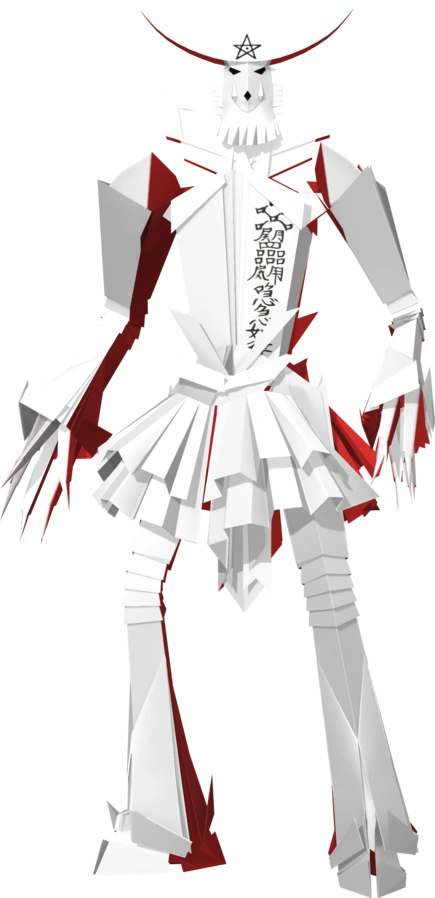
Note: This post was originally published in April 2024. However, since it is a complete research and dive into this monster, I figured out i could just repost it as a Compendium entry.
As always:
Warning: Faith and religion are important real life topics, that tackles the culture and way of life of millions of real life people. It is a cultural expression, and must be respected by all means. Here, we use a video-game ( some times) and other media series only to ignite the flame of learning about the matter, using its art when well depicted, but we do this with all due respect to the cultures we talk here, grounded by real life sources, cultures and people. And i mean this with respect. Hope you all enjoy.
I am sure that, if you played any Megaten game in the last 20 years or so, you ended up seeing this paper dude. His name is always stated as Shiki-Ouji, and he once shared the same design with the Demon called Shikigami.
The weird thing is that when researching Shikigami on my studies, I never found anything about this one so i put some detective work to find out about the origins of Shikiouji, the (yet another) dude who often repels physical damage in Megaten.
The creature is described in many of the series compendium as a powerful Shikigami, that only the most powerful Onmyoji could summon, and they have a vicious temperament.

When we talk about Shikigami, the first thing that comes to mind are paper dolls. This is no surprise, since Shikigami are summons Onmyoji binds to paper dolls or talismans, so they could interact with the physical world. This is also because paper is a very easy material to destroy, if things go south. Onmyoji are the equivalent of western sorcerer, that followed the Onmyōdō, a esoteric cosmology. It started in the 6th century in Japan as a divination practice, and evolved from there. I won't go into detail, because this is meant to be a short post. But materials about this practice are abundant on the internet.
The main concept concerning us here is the Shikigami. These are basically some kind of familiar, a spirit or demon if you want, the sorcerer could conjure to protect him or do his biding. The Cultural Alliance Brazil- Japan, which i already mentioned in other posts, states that:
''Shikigami can be Oni or demons, that should serve and protect an Onmyoji. Your abilities would be determined by the abilities of his master.
A Shikigami could assume the form of small animals, birds, etc... One Shikigami from a powerful Onmyoji could possess and control one animal. But only a real powerful Shikigami could possess a person.
When an Onmyoji is fighting another Onmyoji, they employ the use of their Shikigami. Some Onmyoji could spot the enemy Shikigami beforehand, and try to convert it to his side with magical powers. In this game, the converted Shikigami would come back to the old master, and attack with double the force. This pratice was called Shikigami Gaeshi.
Abe no Seimei is said to be the most powerful Onmyoji to ever exist. Some rumors say he had twelve Shikigami, while regular Onmyoji would rarely have more than one Shikigami at the same time.''
So, that is a rough definition of what a Shikigami is.
But, when researching this creature you would not be able to regularly find Shiki-ouji. The fastest method for him to appear, was the English Wikipedia article about Shikigami, which weirdly had this part about Shiki-ouji, but offered no source to it:

Having the kanji to Shikiouji, and some keywords, i found someone at Tumblr who asked the same question 6 years ago, in Eirikr's blog.
From there, Eirikr offered a link to a blog post writing about Izanagi Ryu Shikoku. Ryu Shikoku is an ancient folk religion and pratices from the Kochi prefecture. It is still practiced in the area to this day!
In this belief system there is the tradition of the Shiki-kui masks. Which.. bear a very uncanny resemblance to our paper guy, subject to this post:
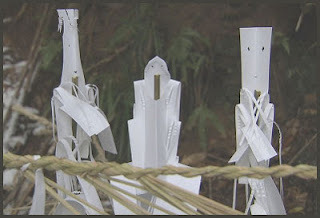
These masks would be hang above the place the ceremonies of the Izanagi Ryu take place. They would have magical powers that could repel evil spirits, and non believers from coming to the ceremony and disturbing it. They would also serve as talismans, or paper dolls, in a simmilar vein the regular Shikigami pop image you have in mind.
Since they are used to summon spirits, bind them, and as talismans, these creatures can be, technically called a Shikigami.
With this knowledge in hands, i went to the Japanese web. And sure enough, i found this site: The Nippon Foundation Library. It has an article detailing the paper talismans used by Izanagi No Ryu Onmyoji, and their meanings, powers, and also explained a bit about Shiki-Ouji!
Here is what they have to say: (Please be warned that i do not speak Japanese, and used machine translation. Any corrections are Welcome!)
Shikē Ōji is a spiritual entity invoked by the taisa during prayers for the sick and the "toriwake" ritual to expel evil spirits causing illness or calamity. Its birth is described as abnormal, and due to its excessively violent power, it has no place to reside. Usually, it is sunk in the pond of Tendō-nanta, and summoned only when needed to guard ceremonies, to pray as the guardian deity of ceremonies, or as a prayer deity of Jumon no hakase. There seem to be several types of Shikē Ōji depending on their purpose, such as Takata no Ōji for toriwake, Gotai no Ōji for prayers for the sick, and Ōtaka-shiki for insect prayers. Additionally, talismans such as Sangoku Arashiki, Chimura San Ōji, and Sakago no Ōji are handed down, and it is inferred that they were used according to the content of the prayers, although many details of their usage are unknown.
Using the powerful Shikē Ōji against humans becomes a curse. In Kochi Prefecture, "hitting a ceremony" is widely used to curse people. Many people use this term without understanding its original meaning. "Hitting a ceremony" refers to attacking someone using Shikē Ōji. While Shikē Ōji can benefit people if used for good, it can harm them if used for evil. Talismans of Shikē Ōji, possessing such terrifying power, often have several incisions on them, each containing twelve notches, giving them a rough impression. However, unlike talismans found in mountains and rivers, they do not seem to have incisions for eyes or mouths. In this regard, they are closer to the cutting style of talismans for house gods and sacred gods. Here, one can sense the emphasis on the powerful nature of Shikē Ōji's talismans while also distinguishing them from strange monsters.
So, as you can see there is some key information about the creature here. But the most important ones:
1- It is bind to a talisman, just like other Shikigami. The text here explains it is a paper talisman with notches, just like regular ones used in religious ceremonies.
2-It has a powerful and violent nature, just like the compendium often indicates in Megaten games. It seems hard to tame and use properly without getting hurt.
3-Shiki-Ouji can be powerful and violent, but it seems they dislike being used to hurt people. Instead, they are better employed to use their magic to other deeds. However if you still use them in that regard, they will most likely curse you.
4-Their talismans have twelve notches, no incision for eyes and mouth due to their aggressive nature. This would help to control their interaction with the material world.
I am sure that, if we follow this trail we will find many more sources. Going by key words i found in this text, i found many other sites and books, but since i have no time now to fall a rabbit hole, nor do i speak Japanese... That is it, i think this is a satisfactory answer to where this Megaten Demon came from!
The real forms of Shiki-Ouji
The last thing in want to talk about, is Shiki-Ouji real appearance. Since we have a seemingly wrong impression of they in Megaten, since Kaneko took some artistic freedoms.
First and foremost: From the few things i studies about Shikigami, we know they do not have a real physical form. The paper talismans are just a way to give them physical form. But it was incredibly hard to find a Shiki-Ouji talisman, which was weird because it was so distinguishable. The main reason being that: Shiki-Ouji seems not to be believed to be easy or safe to summon, and also their talismans would be destroyed asap after use.
But with the description i got, it would be this one that matches it the most:
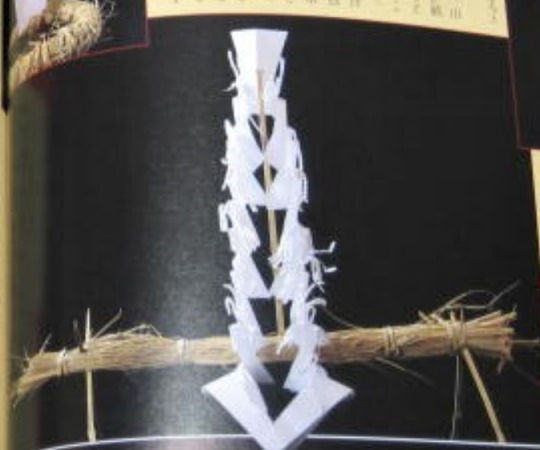
No eyes, or mouth. Twelve Notches, six from each side, and some incisions. Very similar to a regular talisman found in other types of ceremony. Just as the text suggested.
I got this picture from this book:
Tosa, Monobe Village: Shapes of the Gods
Monoba being the village where most of these rituals came from. The book is from 1999, and contains many pictures of actual talismans.
You can see that, aside from the head shape, Kaneko took some freedom with this design. The sources state that Shikiouji talismans should not have a face, nor limbs, since it was too powerful, and should have 12 notches. For some reason, Kaneko drew it in a human-like form, but the face still resembled the Shiki-kui masks. The earlier design of the demon was even more closely resembling the masks:


Shiki-ouji earlier design from Devil Summoner (1996). It was later repurposed as the demon Shikigami. It is almost an exact match to this talisman. I can not however identify the original source.
Shiki-Ouji current design by itself could have been based on this one talisman in specific, at least some parts of it like the head with horned-shaped appendages:
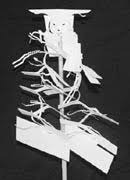
By the looks of it, its face could turn inside out, just like the Megaten Demon can do.
It was sourced by the National Museum of Japanese History, but the post went down. The low quality image of the talisman can still be seen on google, but the link is dead, unfortunately. It seems that this item is still in possession of the Museum in Japan. Kaneko could have seen it in pictures, or in person. This one seems NOT to be displaying a Shiki-Ouji thought.
Maybe the Kaneko take is that Shiki-Ouji was summoned with limbs, and facial features and became much more stronger as a result? We may never know...
And finally there is also an occult book that i found in Amazon Japan that is called: Exploring Izanagi No Ryu: ShikiOuji.
It is supposedly a manual on how to practice Izanagi no Ryu, and magics. I could not find the book online, just the summary. But it mentioned nothing about Shiki-Ouji. Probably has some sort of tutorial to summon it, in fact i was able to find many of those tutorials on the Japanese web.

Now, that is it. I think this puts to rest a little bit of mystery involving the origins of this specific demon. Kaneko sure took some freedoms, but it is still one of the more popular and recognizable characters in the series.
Final considerations:
This most likely is the answer to its origin, but i am not some sort of owner of all truths, so feel free to correct me in anything i said wrong. I am still an amateur scholar, and even if i do know a lot about mythology and ancient religions because i read many books and study a lot of hours of my days, i am by no means a specialist in Japanese Mythology specifically, specially Shikigami practices. The reason is that, i find it very difficult and time consuming to research Japanese sources, since i do not speak Japanese. I will one day, try my best since there are a lot of good Yokai to cover in future Scientific Papers.
I can, however, guarantee that i did my best possible effort in a deep search!
And i have spent a lot of time looking through pictures of Shikigami talismans, and i found some really cute. Like this one. What a whimsical little fella...

#shin megami tensei#atlus#kazuma kaneko#blazescompendium#megaten#mythology#japanese folklore#japanese mythology#shikigami#megami tensei#smt#blazescompendiumentry
74 notes
·
View notes
Text
Detail on Vouivre's Kaneko design that made me enjoy it even more.
One of the things Kaneko's Vouivre was missing was her singular jewel that usually comes with her myths. This jewel is a Carbuncle, an unique type of gemstone that came specifically from the Vouivre.
All her powers, and even her vision are tied to this gemstone which is said to burn hot and shine. It is described as more valuable than gold and it is sought after by humans, who try to hunt the elusive Vouivre.
I talked about it in more depth on my post about the myth
This gemstone is the source of most of the lore involving the Vouivre. It is often depicted in her forehead or being her only eye and source of vision.
For years, Kaneko's Vouivre made me unconfortable because it lacked this feature... That is until i looked closer! You see, Vouivre from SMT does have this gemstone! Look closer!
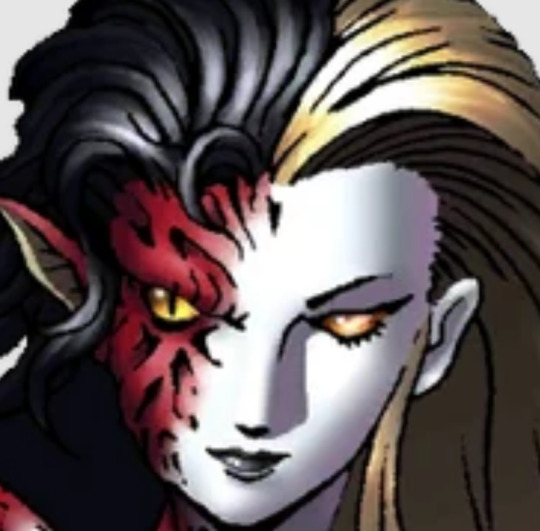

The left eye has no pupil, if you look closely it looks exactly like a gemstone. It looks like a garnet, which matches the description of the carbuncle!
If you did not noticed it, i don't blame you. The low quality of the 2D art we have been used to makes it very difficult to spot. Also, it does not help that the old Devil Summoner Vouivre design lacked this feature. This appeared on her Soul Hackers redesign, which now i quite like!

Low quality rip, but you can see her both eyes are just eyes!
What made me notice this feature is that Vouivre's jewel eye actually shines a bit in her SMT V Vengeance 3D model! It is very hard to spot due to her movements, and the lame fact that you can not approach too much of demon models in the Demon Haunts feature. (Feature that i really loved)
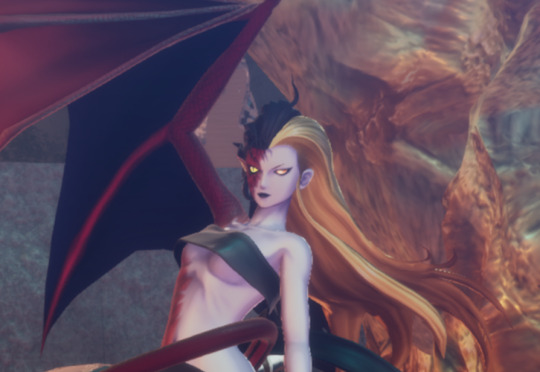
This faint glow on her left eye caught my attention, and made me realise that this design is actually good!
I noticed that during the Vouivre questline, which is also inspired by her lore. Not to spoil, but you have to help a Bethel agent to steal Vouivre's gem at this sidequest, while she is bathing. Exactly like her folktales.
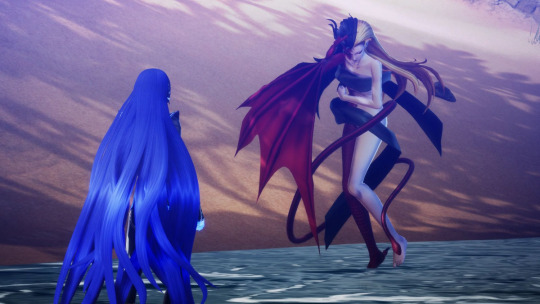
Just let her bathe for fuck's sake...
I really liked this detail, and it would not be possible to spot if it was not by Vengeance amazing focus on Demons. The lack of this feature was my main problem with vanilla V, and i have been in tons of fun with this game for the past month. Sadly i can't play it a lot, but its specifically demon quests are love letters for those who like this topic. At least for the most part, they still got a lot wrong too.
#shin megami tensei#mythology#devil summoner#blazescompendium#megaten#kazuma kaneko#shin megami tensei v: vengeance#vouivre
42 notes
·
View notes
Text
Dormarth finally was got right by Atlus as a dog from Annwn, instead of the wrong compendium entries for them.

Woke up today to this post from Atlus West on Twitter. They actually mentioned Dormarth as a dog from Anwn instead of their regular compendium entries that were not true.
For those who are with me since the beginning, you will remember that my first post in this blog was an investigation of Dormarth's origin, and how it has nothing to do with what the Megaten Compendium has been parroting all these years.
At the time i was not even doing scientific research yet, but i took my sweet time to write over 20 pages of findings from books, to papers and regional folklore. Now, we all know who was really Dormarth:

And it seems that Atlus may have read my post, since they fixed their lore. If that was the case, nice! I personally love Dormarth design, and was happy when she came back for SH2 in 2022, after being only in SMT IV, Soul Hackers for the 3DS and an obscure Raidou novel.
Dormarth also made me fall in love with welsh and celtic mythology in general, which in turn led me to real studies about it. So, this blog post was in some ways a turning point in my personal life.
Can't wait to play with Dormarth in SMT V Vengeance!
#shin megami tensei#atlus#mythology#blazescompendium#megaten#devil summoner#kazuma kaneko#smt v vengeance#Shin Megami Tensei V: Vengeance
33 notes
·
View notes
Text
TV ad for Shin Megami Tensei V (2021).
This ad was removed from all Atlus media, and I think it's a shame because it has more emotional weight for the fans, than anything they did for the 30th anniversary. As someone who played it all, I really feel the nostalgia in this video. Posting here to preserve it!
#shin megami tensei#atlus#blazescompendium#megaten#shin megami tensei v#trailer#ad#almost lost media
109 notes
·
View notes
Text
New SMT V Vengeance demons: Mystery guy revealed as Onyankopon. Anansi official reveal.
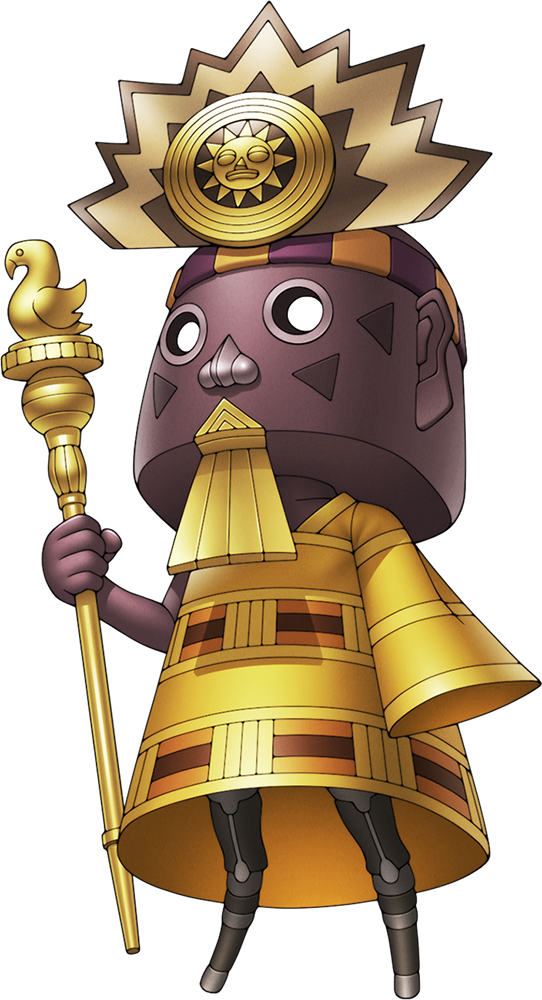
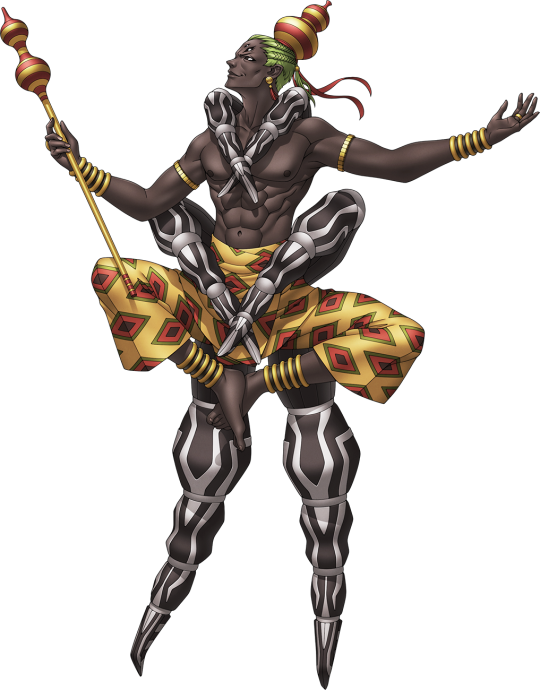
Ok so, brief post because I hyped you all so much for this reveal, and I didn't wanted to sleep on it.
The demon we have been scratching our heads to know about is Onyankopon, which will be from the Enigma race.
Onyankopon is one of the names of Nyame, a god worshipped in west Africa. I personally did not know much about him before, have only read his names somewhere around books or the internet.
This God is supposed to be all knowing and supreme. But it seems that Doi wanted to draw inspiration from other Enigma demons, and also clay figurines. The first thing when you look up this deity on the internet, are clay figurines, so makes sense. Doi made his eyes hollow, maybe to imply that its real form is inside the clay body, but we can't know for sure. It is also missing an arm for some reason.
I was pointed out on discord by Nawell, that in an extensive book on Ashanti folklore, theres mention that Anansi wanted Nyame's knowledge and tried to get it from him. Maybe they will both be featured in some kind of quest, where you have to side with one of them, like every area in Vanilla.
I honestly don't know much of Ashanti beliefs to state anything meaningful right now. But I will love to research it more deeply when I have the time.
Same goes for Anansi, although he is pretty well known in Brazil through African religions. But one can summarize Anansi as a trickster character, that is associated with spiders and really, really wants knowledge.
Honestly? Great designs! It was already time for African deities to be properly represented in SMT. Doi nailed it, and I'm glad the general reception dor these new SMT demons is generally positive.
Ah and... Nyami Nyami featured earlier this week, now has a key art:

What did you think of these new designs? I think I can dissect them properly once I get less busy! But overall I loved them!
#shin megami tensei#atlus#mythology#blazescompendium#devil summoner#megaten#african mythology#shin megami tensei v: vengeance#new demons
28 notes
·
View notes
Text
SMT V Vengeance Famitsu cover is just a family pic...

This little detail made it so much more enjoyable for me! Thanks Doi!
17 notes
·
View notes
Text
Blaze's Compendium Entry #5:
What does the fox say? Ask Cironnup- Kamuy

Warning: Faith and religion are important real life topics, that tackles the culture and way of life of millions of real life people. It is a cultural expression, and must be respected by all means. Here, we use a video-game series only to ignite the flame of learning about the matter, using its art when well depicted, but we do this with all due respect to the cultures we talk here, grounded by real life sources, cultures and people. And i mean this with respect. Hope you all enjoy.
Let's get back to Japan once again, but this time to the northern Island of Hokkaido. There lives the Ainu people. Today we are not only talking about my favorite Megami Tensei creature, but also about very interesting entities, culture and people. Please, sit back and enjoy the ride.
(Please, note that i don't speak Japanese. I had to go over English sources as well use software to translate. If i got anything wrong, let me know!) This time, all sources will be available at the end of the post, since iv used them extensively, it got pretty messy to pin down the exact points, so will list them below)
Cironnup (Also called Chironnup or Chironnupu in Japan) in the Ainu tongue translates to ''Those who we kill many''. And it can be used to describe foxes in general, but also is referred to a Kamuy.
For us to understand what Cironnup is, we first need to dive in the meaning of the word Kamuy, which is very, very interesting.
In the Ainu tradition, Kamuy can be a complex term to translate. It can be defined as a sort of divine spirit, supernatural entity or even a god. The Foundation for Ainu Culture translated it as the word god, when i emailed them about the matter. Its similar to the word Kami, in Shinto Japan. It's a tricky word to translate that has no perfect match in English. But let's go with god.
Sometimes in the modern day Japan, the word can also be translated as Kami, or Hotoke (Spirit). But as their English counterparts, those words don't match 100% correctly the true meaning of the Kamuy word.
The Ainu belief system comes from their relationship with the Kamuy. This belief came from people who have a deep connection with nature, and helped them to survive and thrive in their environment, as well protect them from disasters and other calamities.
The Ainu belief system does not have a central scripture, like the Christians have the Bible. Their views of the Kamuy can be interpreted differently through time and place, but remain somewhat similar. It's good to remember the Ainu is a diverse group. Beliefs, customs and regional dialects can vary from region to region.
But ok, then what is a Kamuy? You ask.
The Kamuy description can vary, but they are spirits, supernatural entities, or gods. They can be attributed to many creatures and objects. In fact, there's Kamuy for diseases, earthquakes, fauna, flora, and more. It's like this belief system comes around the idea that everything and everyone has a soul.
There's not only natural occurred Kamuy, but also the ones that came from man-made objects, like spears, boats.
The relationship between Kamuy and Human are complex. Some Kamuy can provide for Humans, like animals that provide meat and fur, or plants that provide food and remedy. Others can protect and take care of Humans. There's also Kamuy who bring calamities, like diseases such as smallpox. (Sources where keen on Smallpox, it seems it got pretty common in Hokkaido some times.)
Some examples are like the Fire Kamuy, that not only provides heat and cooked food, but also hears Humans and take their pleads to other Kamuy in case they still have not answered. the owl related Kamuy remain outside villages looking after their people.
Another good and very specific example is the Salmon Kamuy. Known as Chep-Kamuy. Salmon was a much needed fish for the Ainu, so they often built their villages next to streams where they could find this fish. Thus the importance.
Kamuy are often portraied as free willed entities. They live their lifes just as we do, and they can be good or evil. Some times they are not eivl, but there can be a conflict of interests between Humans and Kamuy. Being good or bad, Kamuy would only come back to their world once their mission is accomplished in the Human world.
It is said that the Kamuy have their own relatives and friends in their world, so it is at least implied that are many instances of one Kamuy. For example, many Chep-Kamuy living in their world along many Cironnup-Kamuy. For this reason, when a good Kamuy is going home the Ainu offers them hospitality, food, drinks in rituals so they can either thank the entity for what was given.
This way, according to the Ainu, the Kamuy will come back home happy and satisfied, thankful for the Human hospitality. They will tell all their friends and family about how good they were treated on Earth. The Ainu believes that not only the hospitality offered to the Kamuy makes they wanting to come back, but also they could bring more Kamuy along, after telling their relatives about how good they were treated. This also make that specific Kamuy more respected in their world. Both sides having a mutual relationship.
In the case of bad Kamuy, like disease, the tactics were to run away from it. Some Ainu even erasing their own footprints in the snow so they can't be tracked by the malevolent entity. They were also treated with respect, but in more of a fearsome way.
The Kamuy often inhabited animals and plants, for example. So, in the case of wild animals the way a Kamuy go home is when the animal is killed. Hunting deprives a creature of their life, but it is necessary for survival. This act is seen as the Humans liberating a Kamuy back to their world, after have killed their carcass. (In the case of wild animals)
One of the more famous, and important of those rituals were related to the Bear Kamuy. (Kin Un Kamuy) I wont go too deep into it, because it's complex, but basically the Ainu took care of a bear cub for a whole year, even living among them as another member of their society, before slaughtering it with arrows, and eating its meat. This way, the Ainu hope the Kamuy goes to its world grateful for the hospitality and the time it spent with Humans.
-You can remember Teddie from Persona 4 kinda having this motif in his Persona ''Kamuy''.
As you can see, the Kamuy is a fascinating subject. They can be good, bad, they are multitudes, they have families and lifes, their own personalities and interests just like Humans. They can be humble, hateful, have pride or a good sense of humor. They can be related to natural phenomena, animals, plants. There's just a lot to cover about Kamuy.
My note here, but it remembers me a lot of the concept of Jinn and Daemons, from Islamic and Greek pantheons respectively.
BACK TO CIRONNUP, THIS WAS A LONG TURN
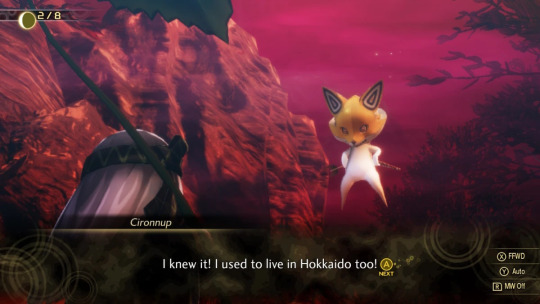
Cironnup-Kamuy is the fox deity in this context. Foxes by themselves were called upon many names in the Ainu culture. Cironnup is one of those names. But it could also be Kemakosnekur which means ''light footed god'' according to the Foundation for Ainu Culture.
Cironnup appears in many tales and are generally known to be Kamuy that listens to people's requests, brings food, can protect against illness and foreign enemies. They can appear in premonitory dreams to warn about calamities. But there are some instances of Cironnup doing mischief and evil deeds, like possessing people, transforming into people as disguises.
As in many cultures around the world, foxes are treated like cunning and natural tricksters. But the Ainu had a deep relationship with the foxes, since they were essential to their survival in some times. They could be deceiving, but also could bring good help. This could explain this duality.
The name Cironnup could also be referred to other creatures, it can be names of villages, and could also describe wild beasts. It could describe many other wild animals that were heavily hunted by the Ainu, but slowly the name was more and more associated with the Fox. (The Fox itself could have different names in different regions as well.)
In the specific case of Cironnup, the premonitory nature of it were also brought by some regions using fox skulls as divination tools. They could also be used as guardians for Sea Fishing.

Cironnup calling its Kamuy friends for help? In Japanese this attack is called ''Kitsunebi Aputo'' Which mixes the Kitsunebi flames, with the Ainu word for rain, meaning a rain of a fox fire. Although... Kitsune is a whole different matter.
In my researches i found a Brazilian web page dedicated to Japanese culture. There, i found a story about the author being hunting with an Ainu, and they talked a bit about their relationship with the Cironnup Kamuy.
According to the author, they were out hunting when he noticed footprints in the snow that were from a Fox. He then proceeded to ask the Ainu hunter if they should go after it. But the Ainu stopped the Brazilian hunter, informing him that if they catch the fox first, the Cironnup-Kamuy would certainly go around the woods telling all other animals they were hunting nearby. Because by killing the Fox, the Kamuy would be liberated of the body.
When the fox was indeed caught, they would tie their snouts, so it would keep its mouth shut and wont spoil their hunt. The author did not seemed conclusive if this was a general and normal hunting behavior for the Ainu, but being a first hand account (And written in my own native language) i found it interesting to post here.
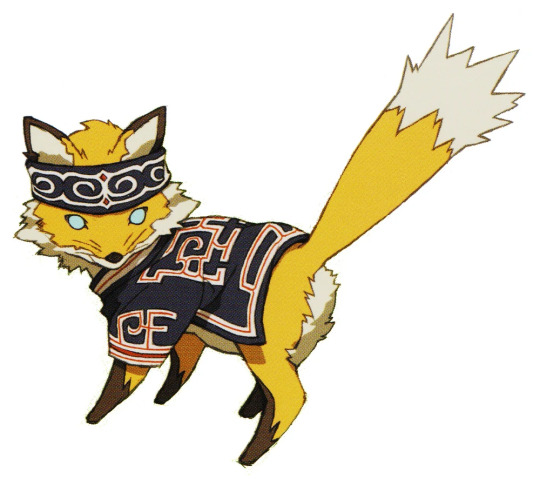
Cironnup's beta design for Shin Megami Tensei IV: Apocalypse. It wears some clothing inspired by the Ainu.
The Human Race has a very interesting relationship with foxes in general. Their depictions usually repeats itself through our history, because they are very interesting animals by themselves. Me myself, I've lived my whole life, in a culture where foxes are absent because they are not naturals to the place where i live.
Their relationship with foxes makes me wonder and reflect about it, since the creature does indeed have a duality. While it can be deceiving and cunning, it has also a protective nature, it is strong and some times even lovable. Foxes are also signaled worldwide as an awareness and investigative symbol, which is also portrayed by Cironnup, sometimes presenting danger from far away.
Still worldwide, the foxes are treated like the tricksters of the nature, masters in deceiving and playing pranks.
The Ainu fascinated me not only as a culture, but also in their relationship with the nature, not exactly looking at the world around only as resource, but also with care and respect.
I hope one day i can visit Hokkaido and learn more about the Ainu culture personally.
-Ainu online dictionary Ainu-to-shizen Degitaru-zukan”by Ainu Museum
Sources:
-Akarenga JP (A Hokkaido culture foccused web page)
-Commentary on the book “Karirinka-to-kitsune-no-kamisama” [カリリンカときつねのかみさま] (2012) by Sakiko Yatani Provided by the Foundation of Ainu Culture
-The Foundation of Ainu Culture (Inquired via e-mail)
-Ainu Legends, Cironnup Daisuke Tchê (The tale about the Ainu hunter, in portuguese)
Special thanks go for @researcherposts for helping me reaching the Foundation of Ainu Culture.
Again, if i got anything wrong, please correct me! I will be more than help to fix anything :)
#mythology#ainu culture#Cironnup#Ainu#hokkaido#mythology and folklore#shin megami tensei#atlus#blazescompendium#blazescompendiumentry
100 notes
·
View notes
Text
Blaze's Compendium Entry #6: Helmet is required to deal with the Muh Shubuu.

Warning: Faith and religion are important real life topics, that tackles the culture and way of life of millions of real life people. It is a cultural expression, and must be respected by all means. Here, we use a video-game series only to ignite the flame of learning about the matter, using its art when well depicted, but we do this with all due respect to the cultures we talk here, grounded by real life sources, cultures and people. And i mean this with respect. Hope you all enjoy.
Moh Shubuu, or Moh Shuvuu is a fantastical creature from the Buryati Folclore, nomadic people from Asia in a region between Siberia and Mongolia. Their are treated like a Mythological bird, that is born when a young girl or young woman dies by violent means, without knowing true love. (This can imply chastity, but it will vary in how explicit it says it). Normally, Moh Shubuu will attack man that she could seduce using her young girl looks, bringing the victim to isolated areas of the desert and killing them with a blow to their head, using their ominous sharp beak. Then she would proceed to suck and consume the brain matter out of the person.... Yikes.
According to sources (as always, will be in the boton) There are other ways for a Moh Shubuu to be born, we will explore those later.
This is one of those legends that, finding a single western source on it is way harder than actually understanding it. Not even Wikipedia is of any help here (That is, if it was of any help, any time). The only real English source i was able to locate was a book: ''Christian Demonology and Popular Mythology, Central European, 2006''. Although this book was a verifiable source, it was not from much help because of the biased view of the tale, from a Christian perspective. Which is not exactly wrong. There's whole fields of theology dedicated to this , but we gotta exercise the Methodological Agnosticism here, which means i can't analyze a culture going from other completely biased point of view, but rather try to see by the eyes of said people considering their time and space, which is also not a easy task by any means.
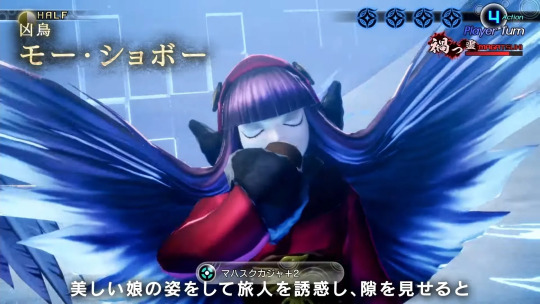
Moh Shubuu hides her beak with her hands, and sleeves.
The book offers little to no insight about more than what is commonly associated with the Moh Shubuu. The western internet is filled with texts and people talking about this legend, in the way i told above. But the creature name gets a bit confusing. Usually, in the west people call it Moh Shuvuu, but it seems this is a western way of spelling the name, which is actually Moh Shubuu or Moh Shubuun. This means literally somehting like ''Evil Bird'' According to most sources, but i was unable to independent verify this claim. So, take it with a bit of salt. I am sure though, that this could not be so much far away from what it really is.
Going by Muh Shubuun or Moh Shubuu makes it more easier to research it, in Russian the name is spelled like: Муу шубуун. In using this language, there is a good amount of sources going from sites that talk about mythology, to museum pages in general, to books. This did not surprised me, because Buryatia being part of Russian territory for centuries now, and Moh Shubuu being a relatively obscure, and oral folklore, makes it very niche to research indeed. Specially from a culture which is in high danger of disappearing. [2]
But by far, the most complete work in Buryatian culture research i was able to find, comes from a renowned Russian folklorist: Matvey Nikolaevich (1858-1918). His work is extensive and very detailed, he spent his life and career studying and documenting Buryati culture. Matvey was celebrated in his time by his expeditions to Buryati settlements to study their culture, and he was elected in 1888 as a member of the Russian Geographic Society. So much so, that a Museum in Buryatia is named after him, and display many of his belongings and researches there. (Linked source, and Museum)
If you happen to speak Russian, and is interested in learning more about Buryatian Folklore, culture and more i heavily suggests you to read more of Matvey books. As for me, i do not speak Russian, so i am relying in software translations. If you notice anything wrong, please let me know!
I can't go too deep in his work here, because our main goal here is to explore the Muh Shubuu lore. Luckily for us, Matvey catalogued this very tale (along with another multitude of Buryati folklore) in some of his work. Here, i will use as a basis his book:
‘’Хангалов М.Н. Собран��е сочинений в 3 т. Т.3. / Под ред. Г.Н.Румянцева.-Улан-Удэ: Изд-во ОАО «Республиканская типография», 2004.- (Reprint)’’
Translated roughly as:
‘’Khangalov M.N. Collected works in 3 vols. T.3. / Ed. G.N. Rumyantsev.-Ulan-Ude: Publishing House of JSC "Republican Printing House", 2004. (Reprint)’’
This work was originally published between 1889 to 1903, in 3 volumes focusing on Buryati Folklore. Sadly, i could not locate this book anywhere on the web, at least not using software translation and all my power to do so, i could not locate a physical copy of easy access for me. But, luckily the book is partially transcribed in many web pages and that's how i guided myself.
So, about the Muh Shubuu!
There are some legends Matvey catalogued about this demon in Buryati folklore, but they vary a bit. This can be because of the nomadic nature of the Buryati people, and how the tale can evolve and change between groups and settlement. But nevertheless, the essence is still the same. Here are some tales that Matvey could comply about the Muh Shubuu:
There is, for instance the tale of a young couple, that went to live in the woods together. Sadly the man dies from illness shortly after, leaving his wife alone and depressed. The woman could not bear the loss of her husband, and was driven into madness. During this time, she decides it is a good idea to consume the dead decaying liver of her late husband. After that, she dies as well.
The woman's soul is back as a Mu Shubuun, because of her terrible act. Still according to this particular legend, this demon can change forms into different types of birds. (like some kind of warebird) But, when she transforms back to her more humanoid form, only the beak will remain. (Some times, this beak is described like her lips) The beak will always be visible, no matter how many times she transforms back.
Another tale tells about a hunter, who was hunting alone in the desert. (or woods, depending on the mood of my translation software) After taking a rest, a young woman approaches him. She starts to kick a conversation, cracking jokes, and getting along with the hunter. He noticed that the woman always tried to hid her lower face with her sleeves, and found it suspicious. He notices this is a Mu Shubuu, and asks her to get logs to the fire he is preparing. She goes, and while she's away, the hunter puts some branches and his stuff into his blanket to give the impression he is sleeping in it.
When the demon returns, she thinks the tired hunter was sleeping already, and she could finally attack. She jumped in the blanked with her beak, stabbing the branches and logs he put inside it, and it got stuck. That's when the hunter shoots the thing down with his gun. After that, he burns the remains in a fire.
This story is particularly interesting, because it involves guns, so it was probably not that old. At least this version, it could have changed with the years, with regular weapons becoming guns, once they were invented and got popular. Or... My translation software got something as an bow and arrow as a gun.
This tale also makes clear that the creature was about to kill the hunter, with her classical ''beak to the head'' and would probably consume his brain matter. But there is evidence Mu Shubuu diet consisted of more than just brains. like the woman in the first tale eating the liver of her husband.
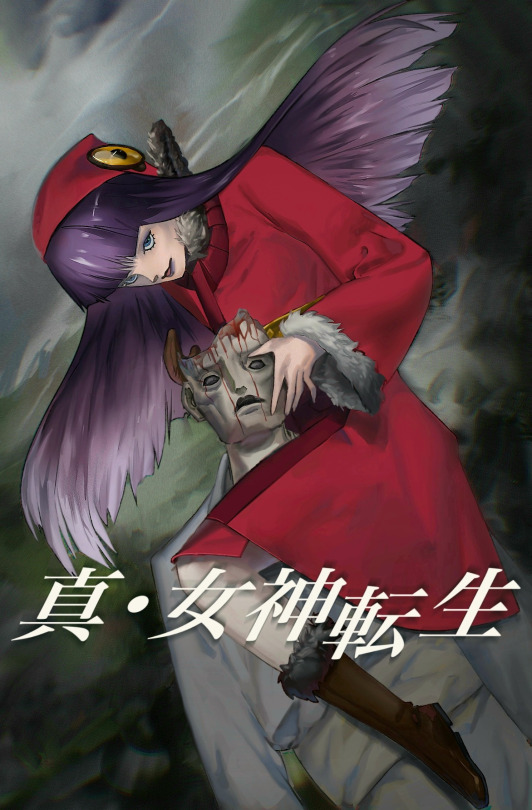
This amazing artwork was made by NATZ they are amazing, and let us use it to illustrate this text. Go check them out! I am a big fan!
In another tale, there is also other person who win in a fight against this demon by getting her stuck in a tree. This seemed to be enough to the creature promise not to bother anyone anymore.
Matvey also complied the information that, some tales described that Mu Shubuu had two ''flints'' with them, usually in their armpits. The right one is a bright red flint, very good looking. The other one is a decayed and rotten tool. The disgusting one is the one to destroy, or take from the creature, because it is linked to her vital forces, it seems. During a fight, Mu Shubuu will try to convince you that the red one is better, but this is a trap. This flint will weaken you instead, making you the easiest prey to this demon.

Buryat knife with a suspension, a tube, a pouch, a flint. Silver, coral, malachite, mahogany, leather, hardened steel, corals, chasing, punching, forging. I dont know, but maybe this legends of a ''flint'' could be referring to the tools here.
There is also the implication that there are male Mu Shubuun as well! According to Matvey there was a tale about a forest where lots of Mu Shubuun inhabited, and they always caused mayhem in the region, attacking and eating people's brains.
One day, a warrior decided to go there, and was (surprise surprise) attacked by a Mu Shubuun. In this story, the flint version was accounted for, and the warrior win the fight taking the ugly looking flint from the demon. But, she ends up fleeing.
The man follows the creature trail up to a well, where he found not only the female Mu Shubuun that attacked him, but a male Mu Shubuun. It was the male that convinced the guy not to harm them, explaining that attacking humans was an habit of the female Mu Shubuun only. As a way to apologize, the couple of demons teach the man how to defend himself from their relatives, using magical phrases. I could not translate them very well using software, but in Russian it goes as:
‘’Хадалан долон - Хадалаевы семеро
Хамнагахи найман - Хамнагановы восьмеро’’

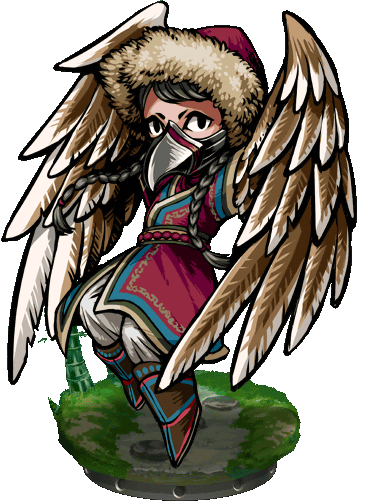
Female and (possible) male Mu Shubuun from the game Blood Brothers. I like this interpretation very much, because of the bloody beak.
This tales are interestng, because they are very small but they manage to convey a lot about this creature, which is sadly not very much available to western sources. It is evident that in Buryatia, this is a relatively known folkloric tale, and in Russia and Eurasia it was spread by books and the internet, much before the demon was explored in the Shin Megami Tensei series.
For instance, the Irkutsk City Museum, in Russia has a page dedicated to Buryati culture, and also shows some Mu Shubuun texts. Irkutsk is not in Buryatia, rather is a bit north, after the Baikal lake that separates Buryatia from the rest of Russia. But it is close enough to have some cultural connections.
(Again, i am not going too deep into the Buryati belief system as a whole. Not only because that's not the foccus here, but because it would need much more research. If you want me to talk about more of this culture in the future, let me know!)
Much is talked about the Buryatian Shamanism when talking about the Buryatian folklore. This was present in Matvey's work, as well in official government sources as the Irkutsk Museum. This Shamanistic culture often deals with lots of problematic spirits. Those are usually translated as bad spirits, ghosts, or even demons. This means our little devil bird girl is not alone in this pantheon. Just to be brief about some other Buryatian mystical creatures:
Ada: A spirit that manifests itself as a small crature with only one eye, and one teeth. Their mouth is on her lower jaw. Can appear as a dog, children or even inflate itself as a balloon. (This one is specifically creepy, and it is also cited by Matvey works)
Anakhai: Also spotted on the before told sources, this is a cyclop-like creature that attacks children.
Ezykhe: A spirit that causes harm to domestic animals. Usually it appears as a decaying old hag, that steals cow's milk. This can cause malnutrition to calfs, and even death of livestock.
The Buryati usually are practitioners of Tengrism. This is a belief system that is sustained by the relationship with the Earth, being protected by it and the ancient spirits. It is interesting that, in some sources the Tengrists believe that the skeleton is sacred, because it stores a part of the Soul. They went as far as to not damage animal bones during sacrificial rituals. So, since Mu Shubuun has to break open the skull to eat its prey's brain, i wonder if it is seen as a even more evil act by them. [sourced by Buryati Religion and Society’ from Lawrence Krader, 1954]
As is the case with any culture, we need to know a bit of the time and place to understand the collective consciousness that give birth to such myths. The Buryatia territory as a place and the way of life of the Buryati people is essential to this mixture. For instance, being nomadic people that relies a lot in livestock and surviving the harsh Eurasian deserts and the SIberian tundra, the worst fears would often be dictated by those essential pillars of their lifes.
A creature that can slowly kill your livestock? A predatory demon that kills you alone in the desert, sucking your brains? Those were real fears. It is hard to dive deeper into Buryati culture in this text, because it is just a crop honestly, but is also very important to remind ourselves that the Buryati are a diverse people, and some behaviors, tales and even words can change from place to place.
There is definitively a lot to learn from their culture, and a lot to preserve. Being endangered to disappear, it is always interesting to spread the word to more people that could study and preserve Buryati history.
If you are interested, i can recommend also the paper ‘’Buryati Religion and Society’ from Lawrence Krader, published originally in 1954. It is not perfect, and it is pretty old, but it is a good start! It is one of the few English sources about Buryatian culture out there.
Mu Shubuun is a very interesting case of a regional folklore making a trip from it's mother culture and ending up appearing in pop culture. Even with UN classifying the Buryati language to be highly in risk to be extinct, this predatory bird devil ended up in games and known in many parts of the world. In SMT for instance, she ranked 9th as the most popular demon in recent years, as well is a recurrent character in almost every franchise release since the 1990s.
Kazuma Kaneko's design is great for me, because it interprets the beak as disguised as the creature hair, or is it hair and just looks like a beak? That is the magic of his take on the creature. I am just curious on how he got to this specific folklore in the first place.

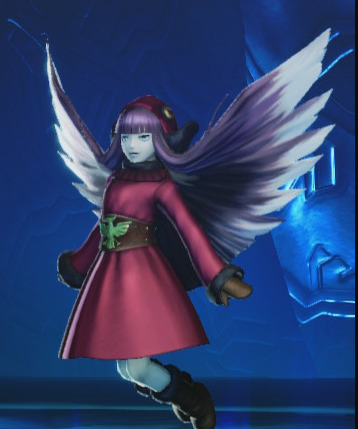
Kaneko took inspiration from Buryati female clothes when designing Mu Shubuun appearance! Very neat. SMT Moh Shubuu lacks the beak, but its hair its styled like a bird's beak, head and wings in a very cool nod to its nature.
It is fascinating to think this happened, but it got me thinking that Mu Shubuun was a product of a culture, and real people that lived by this for centuries. As the warning says in the start of the text, we can use popular media to spark a flame of interest in the matter, but this has to be done with all due respect.
The next paragraphs are based on my personal opinions upon studying this tale extensively. But you feel free to disagree with me, or even correct me!
In my personal belief, Mu Shubuun is one of those Folkloric cautionary tales. Not only not to wander alone in the desert, which could be fatal by very real means, but also that violence against the more vulnerable could have consequences. In the case of Young Woman, this could end up as a Muh shubuu coming to enact her revenge.
Another personal observation of mine: The creature carrying flints reminded me of the old Korean tradition of young virgin woman carrying daggers in her clothes (usually in their arms as well), so they could commit suicide if endangered to be sexually harassed. [1] This could be nothing related, but i thought about it immediately after noticing the flint trope with Moh Shubuu.
As why the bird connection, i really can't say for sure. Probably because raptor birds could be menacingly common, around. But i should study Buryati culture deeper in order to be more accurate about it. End of my personal opinions
Be any reason why this tale survived centuries and ended up here, in the internet, videogames, and other works, is a mystery to me. Maybe the idea of a vengeful spirit taking her grudge on male society is alluring to some, maybe it was because Kazuma Kaneko really did an amazing design, and maybe it is because there is something about regional tales, folklore and beliefs that really fascinate some of us. Some distortions may have occurred in the way, but it is also part of this process. To me, it is important that Buryati traditions and culture can be preserved, and for many, Mu Shubuun is the link to this cosmos. That is a very interesting thing, and i am quite fascinated by it as well.
Thank you for reading up until here!
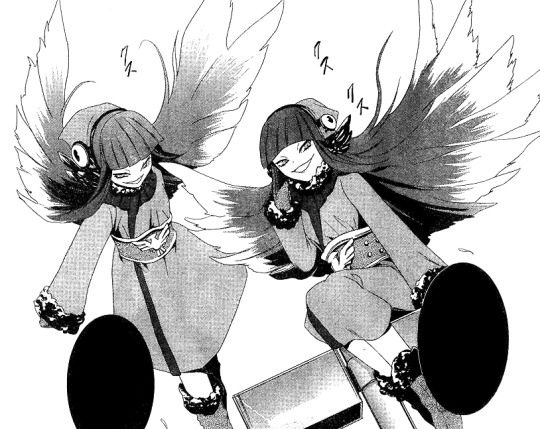
Sources:
-Matvey, Collected works Volume 3, pages 25 to 26 (reprinted in 2004) - (Хангалов М.Н. Собрание сочинений в 3 т. Т.3. / Под ред. Г.Н.Румянцева.-Улан-Удэ: Изд-во ОАО «Республиканская типография», 2004.- С.25-26’’)
-Irkutsk City Museum
-Buryati Religion And Society, Lawrence Krader 1954. (Sadly paywall...)
[1] - Korean Perceptions of Chastity ceptions of Chastity, Gender Roles, and Libido; F , Gender Roles, and Libido; From Kisaengs to the Twenty First Century (This one is just to back my claim about similarities)
[2]- The troubled state of the Buryati language today, Dulma Batorova
#blazescompendium#blazescompendiumentry#buryati#mongolia#shin megami tensei#kazuma kaneko#atlus#megami tensei#folklore#mythology
70 notes
·
View notes
Text
New Shin Megami Tensei demon accidentaly shown in a Famitsu Screenshot for SMT VV

I feel old, because this reminds me when i was a kid and the new Pokémon game would be announced, and every trailer have these unamed new Pokémon, that you could only see for a brief frame, and everyone went crazy.
It seems it is happening with SMT VV now, there is a new unamed demon shown in a screenshot. Here is the complete shot:

Do you have any idea who could this be? Reply this posts with your best shots. Maybe we can figure it out before the game releases lol
#shin megami tensei#atlus#mythology#blazescompendium#megaten#new demon#shin megami tensei v: vengeance#SMT V#SMT VV
13 notes
·
View notes
Text
Shin Megami Tensei and social commentary
Twitter sure is a weird place
So, yesterday i was reading the tweets from Larrue, which is a great content creator if you don't know. And some fans, including me, engaged in a debate over the idea that, according to one specific person in that thead, Shin Megami Tensei ''isn't about politics'' and ''westerns have projected their frustration with politics into the series.'' I absolutely did not know that someone could think this way about a series that grounds itself in social commentary.

I have played SMT Strange Journey during one of the worst times of my society. 2020-2021 we were being ravaged by the Covid-19 pandemics (Please note that more than 600 thousand Brazilians lost their lifes during this crisis, in part due to terrible management of the government.) and environmental destruction lead by a party of completely evil people.
I remember one particular weekend, where a pretty important and big national park caught fire. The way i found out about the forest fire was because, when i got out of my apartment to take out the trash (the only time i got out during pandemics, honestly) and i found a neighbor looking to the sky in chock, when i looked up as well what i saw was a rain of ashes, like someone just exploded a paper truck above us. The ashes were being scattered everywhere, and the air was heavy. When i got up and turned the news up, i just found out the worst forest fire in my city was taking place.
(Do not mistake this for the Amazon Rainforest fires of the late 2010s. My city is very far away from there, but i think the point is still the same and could absolutely be applied there as well.)
The media outlets were hard to watch during this time, because the continuously increasing Covid body count won't stop, while the big capital guys pushed us, the poor, to work at the streets and put our lives at risk. At the same time, the news of the destruction the fire caused were horrifying. Tons of wildlife was burning and the State and people in power did nothing to help. We could not help, because our own lives were in risk.
I recall seeing reports of firefighters claiming to be following the screams of wild animals being burned alive, while trying to save what they could, but in the end it was not enough. 80% of the forest went down that weekend, and with it almost everything that was alive there as well. The reason for this? Someone lit up a Lantern inside the park, which is illegal by the way. This was when it sank to me, the stupidity of the Human being to destroy something so precious, for this little. How can even someone sleep at night with such a burden in their consciousness?

At the time i fell to a violent depressive episode because of all that was happening around me. And the reason for me to bring this all, is because i was actually playing Shin Megami Tensei: Strange Journey for the first time, during this event. I was exactly at the Horkos chapter, where the crew of our spaceship arrive inside a level of the mysterious Scharzwelt that looks like a Shopping Center. This level symbolized the greed and consumerism of the Human Race during the late stage capitalism. Its boss being Horkos, a demon that is hellbent in consuming everything, every time.
Horkos here is the greek counterpart of Orcus, the roman god of death. This particular deity is violent, and will consume enemy troups and cause havoc. (I can go deeper if i ever do a Compendium Entry of this one) It is also depicted during medieval times as the probable inspiration of the Orcs, which is the reason they both share similar designs in Megaten.
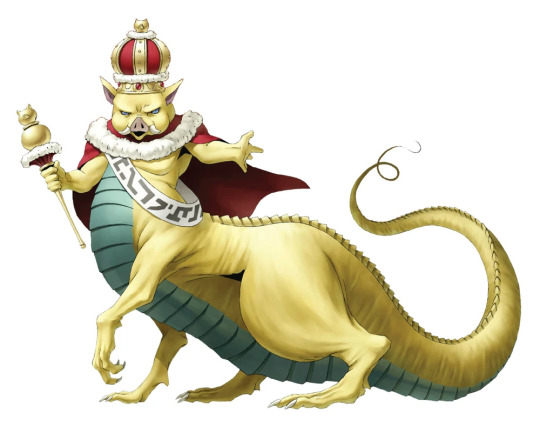

This glutton evil god is born out of the Human nature to consume and spread without limit, destroying and ravaging the planet as they do so. This point is brought many times during the plot.
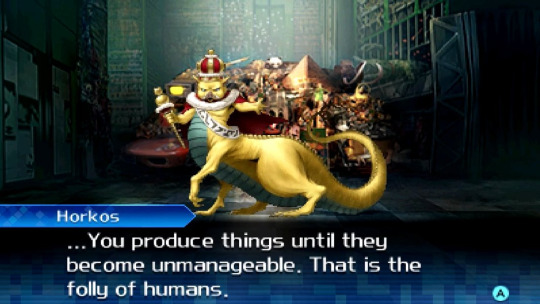
The reason i am connecting this all together, is because when i was playing, i felt that the criticism got so close home, i contemplated stopping playing, thinking that i was not with the right mind to do so. I continued though.
Strange Journey does not stop right there. Each level of the Scharzwelt has one more criticism to Human society, it goes from war, to capitalism, to enviromental destruction, and its a great journey on what is about to be Human. So much so, that i felt it so close home, it made me feel kinda bad. I mean, it was hitting very close home, during that time. Every week the news made me feel like i was going a level deeper inside the Scharzwelt.
So, i am sure the game where a gluttonous evil god is born out of Humanity's late stage capitalism and we feel the rage of gods for destroying our planet has absolutely no social commentary whatsoever, and any politics in it was purely inserted by us, the players. Yeah, i am absolutely positive about that huh!?
In the end, it is indeed just a video game. It is as deep as it can be, but this don't stop the medium to convey such strong messages and criticism of Human Society. I am not even going into what Atlus staff say about the matter here (Which do back up this argument) , because i wanted to make this as personal as possible, so maybe when you think about this, you can insert yourself in the shoes as someone experiencing Human society in a personal view. Which, in truth is all what politics is about. See? Hah, got you Twitter anon.
Politics is not what the left want to discuss, and has nothing to do with projecting societal problems into neutral stuff. Politics is the science behind human behavior in society, and thus every work that touches this, ended up being political. I am sorry to be the one to bring this to you, anon from twitter.
To see people swearing SMT doesn't has a social commentary, it's just baffling to me because I felt it so strongly in this entry, that i almost stop playing it for a while because I was depressed on how much of it was true.

Not entirely related, but very interesting quote in Nocturne
50 notes
·
View notes
Text
Tlalocmon a new Digimon based on Tlaloc, Aztec god of rains and water: How does it stand up?
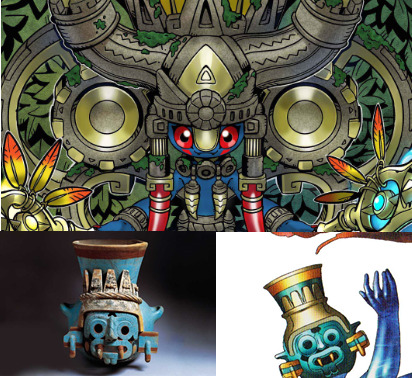
You need very little checking to know that Tlaloc is one of the most important and popular Aztec gods. Presiding over Rain and water, Tlaloc held significance to the lives and beliefs of those who worshiped him.
Recently, the Digimon franchise introduced us to a new monster, due to feature in their newest virtual pet device release. This creature is Tlalocmon, and is based on the same Tlaloc from Aztec mythology. It is not the first time Digimon deals with Mythology, Religion and Folklore. Actually, it is rooted in this franchise's core. And i honestly think they do a way greater job into understanding cultures, depicting and adapting it to their themes, then Megami Tensei, which... Is a discussion y'all are not yet ready for!
But, let's analyze Tlalocmon, and see how it holds up to his non-digital inspiration, here on Earth. As always, sources will be in the end of the post, which is just a crop, really. I encourage you guys to dive in the sources if the topic interests you! I will keep it simple, thought, because this was not meant to be a giant post.
For a very brief introduction Tlaloc (pronounced: Tlá-lok) is a central Mexican deity of waters and storms, that was mainly worshiped by the Aztecs. Although he is much spoken of, and very popular, he was not alone in his tasks, often accompanied by the goddess Chalchiuhtlicue, his current wife. They lived in the underworld called Tlalocan, where they kept the waters of all 4 quarters of our universe. There were other beings residing in Tlalocan, called Tlaloques, that also helped on those tasks. [1] Talk about a healthy and productive work environment!
Mortal souls could go to Tlalocan, according to Aztecs beliefs, if you died from the following causes: Drowning, lightning strike, dropsy, gout, leprosy, scabies, aches and pains, etc... People with certain traits as the physically disabled and with stunted growth would also be destined to meet Tlalocan, once they became a shirt of forever missed.
The author Kay Read, which wrote several books on Aztec Mythology theorizes in her book ''Handbook of Mesoamerican mythology'' that Tlaloc's importance and influence was a result of the Nahua civilizations inhabiting a very hostile and semiarid environment. Which makes a lot of sense. It was also said Tlaloc kept the waters of the universe in giant mountains, like pots. When the time came, Tlaloc would release these waters upon the Earth. [1]
Still according to Read [1] Tlaloc image remained very consistent as years came by. The key features were his ''goggled eyes''', fangs in his mouth were its key features. Some times it was depicted in pottery with lightning. Tlaloc had a temple mayor in the Aztec Capital of Tenochtitlan, which showed his importance. Tlaloc also was related to summer solstice, wet agricultural season. [3]
Tlaloc was born, according to the Nahua/Aztec, created by Huitzilopochtli and Quetzalcoatl. His wife was also created by the duo, the after mentioned: Chalchiuhtlicue. (Although he was once married to Xochiquetzal, she was stolen by Tezcatlipoca, ending their union.) Tlaloc name could be translated as something as ''Inside the Earth'' [1]. Just before the rainy season, Nahua took part in Human sacrifices at Mount Tlaloc, t nourish Tlaloc and his peers to have the strength to break the pots of the waters in our universe. [3]
Another very important feat of the God, according to Aztec mythology is that Tlaloc consumed one of the four suns, raining down into this age. If the current fifth age would like to be continued, the Aztec should keep the god well nourished. [1] Also according to myths [1] Tlaloc helped the Mexica to defeat the Toltecs, previous people in power, bringing fresh rains to the Mexica while starving the Toltecs in droughts. So important was Tlaloc, that when the invaders from Spain arrived, Motecuhzoma II made a gift of a garb of Tlaloc to give it to Cortés. Cortés, being the stupid asshole he was, of course did not liked it. [1]
Tlaloc was also associated to jaguars [1], [3]. He would be often depicted with it, or wearing something resembling a jaguar. There is also evidence that Tlaloc was being worshiped in Central America even before the Aztecs were present. [3]


At first glance, Tlalocmon matches this profile quite well! I love the artistic freedom the designer had, by converting its eyes from the goggled ones, to the characteristic Digimon eyes, that artist Kenji Watanabe popularized by his designs. It also has the notorious fangs of the non-digital counterpart. The blue color of the skin is another trait correctly borrowed from our world's Tlaloc, while not all of his depictions were blue, most of the surviving artifacts we have are in fact colored blueish. You can see it from pottery, to illustrations and other works of art from the Mexica. [1], [3]
Where the designer really went crazy is Tlalocmon's fit. First, the entirety of the Digimon ''Armor'' seems to be made of stone, and almost (or should i say, tries a lot to) share some architectonic resemblances to Aztec style. I say ''resemblances'' because it is mostly, generic architect gibberish. Not to say they did not try to stay true to their sources, the sides of the helm seems to be two columns that, although share some greco-roman traits, are trying to emulate Mexica architecture. I searched some books, and articles about Aztec architecture, and i could not find any matches to what they were trying to portray [2], while i had seen it in more generic drawn Aztech constructions. But this does not mean Tlalocmon's armor is lame, actually you will see soon enough it shines pretty bright under the certain lights...
The entirety of its armor, and plates is depicted with moss and plants growing over, and it seems dilapidated. Maybe trying to portray the abandoned ruins of temples in Mesoamerica. Personally, i am not a big fan of it, because it suffers from a problem that usually media depicting the Mesoamerican cultures have: Their culture, lives and construction were full of color! You can see it even by the Spanish Invaders illustrations. The dilapidated aesthetic associated with those cultures are a relatively new movement. You can easily trace it back to the early 20th century, when the ruins of those civilizations were being re-discovered, already in a decadent state, after centuries of abandonment. That, however was not their real state. But i will consider that Digimon usually tries to amalgamate pop culture into its designs, so we let this pass.


The feathers in his helmet are a directly reference to illustrations of Tlaloc, even the colors are very close. These same feathers are repeated through the design, which are also accurate as far as my research goes. The horns are something the designers got a bit of freedom with, since there's almost no evidence of horns in any Tlaloc imagery i could find, except of course for this one.
The lush greens growing out of Tlalocmon can be 3 things: First, a necessary nod to its product, Tlalocmon is being marketed as a new Digimon of the ''Nature Spirits'' archetype, so its design needs to have nature inspired themes. It also can be related to the ''old ruins'' aesthetic, but i believe it fits well with Tlaloc relationship with wet agricultural seasons, and plants thriving under wet climates. Maybe a mix of all of the above? Most notable, Tlaloc was known by having a cape as a feature,[3] which can be kinda of seen by the plants growing in the back of Tlalocmon, when seen from afar they instantly looks like a cape.
Tlalocmon's main body structure is a bit childish and small in stature. Those features were associated with this deity as well, it often requiring children sacrifices [3], [4]. Also the Tlaloque from Tlalocan, and even Tlaloc itself were often depicted as small in stature! [3], [4] I personally like the childish appearance of this design, because of that.
But for me the real genius of Tlalocmon helmet and armor, can only be seen when you remove a bit of detail, and the own Digimon from the picture. Using my poor Photoshop skills, i ilustrated how Tlalocmon's helmet is in fact... The real Tlaloc's head! Or at least, is referencing it:

This is simply genius!
The blue color of Tlalocmon is also referencing the constant imagery Tlaloc had. Of course, he was not always blue, but most of the time it was depicted as such. [3]
The last bit of the design i would like to comment is the staffs Tlalocmon holds. They are clear nods to the origin of this Digital Monster, this being Tlaloc domains: Water, storms, and lightnings. There is duality here: The rain that gives life to the land, but also can destroy it with storms. This was also associated to Tlaloc. Remember he destroyed one of the last eras?
At first, i did not think much of those staffs, but diving into the sources that 'Arqueo e Espírito' sent me, it suddenly clicked to me that they are referencing Aztec digging sticks, a type of tool the Aztec used to sowed the crops! This is another genius touch to this design, because not only Tlaloc was associated with this tool [3], [4] but also with crops growth. Having it as the main weapons of this Digimon, wielding both water and lightining are an amazing touch. Of course, it was heavily stylized to match the franchise. But it still there!

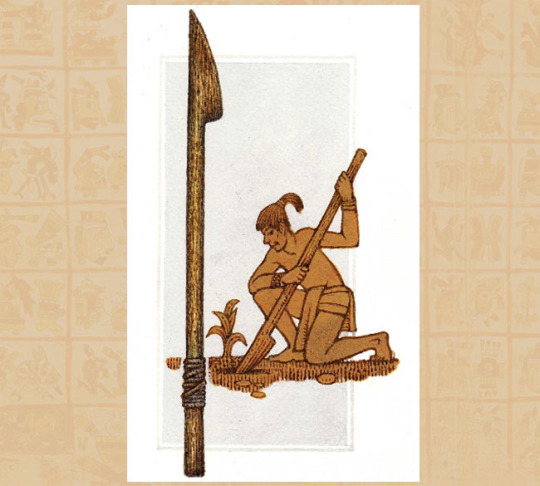

Tlalocmon's dig stick seems not too usable to sow the crops, but at least is a cool magic staff...of sorts (?) There's also no instances i could find of those sticks being ornamented with feathers, but still...
And those were my thoughts on Tlalocmon's design. This Digital Monster was brought to my attention by good friend, @atmaflare. As he guessed, i really liked the design. They took some liberties with it, but Digimon aesthetic often needs this treatment, as for the reasons i already stated.
As i said before, Digimon is a franchise that makes good points on Folklore, Mythology and Religion. Many of their medias are centered around it, such as the last game released: Digimon Survive. For me it was kinda refreshing to see a take in Tlaloc that does not involve pottery of any sorts, but still tries to remain faithful to the source material. The designer clearly did their homework here!
I wait to see Tlalocmon's official profile when it releases with the product it is advertised for, the Pendulum Color Virtual pet. I can only hope he dwells in caves and mountains through the vast plains of the Digital World!
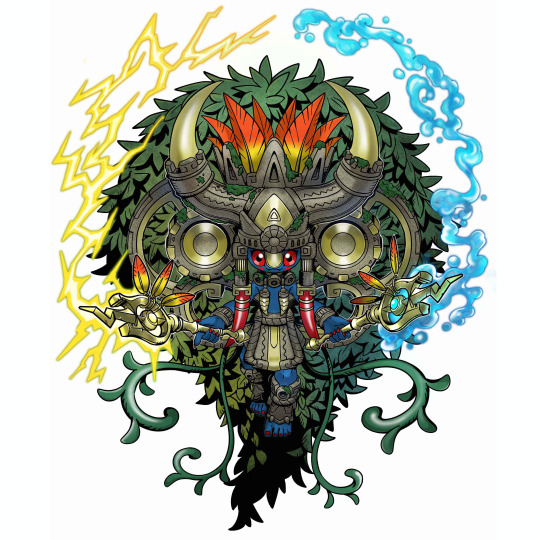
Please, note that i am not a Mesoamerica specialist. That was not my exact area of study, but i do research mythology in general as a part of my Religious Sciences degree's curriculum. So, if you notice any mistake or misinterpretation of my part, please reach me and i will absolutely correct it given the soures and context! And yeah, i plan to take some classes and courses on Mesoamerican culture soon enough, there is so much stuff to study about it!
Sources:
-1: 'Handbook of Mesoamerican mythology' - Key Read
-2: 'StudiesinAncient Mesoamerican Art andArchitecture Selected Works byKarlAndreas Taube'
-3 https://www.mexicolore.co.uk/acrobats/319_1.pdf (This amazing article was sent to me by the great ''Arqueo e Espírito'' They study mesoamerican culture and publish about it on the internet, and are to this date one of the best sites on my country about the matter! This material has other good sources, since im doing just a crop, i highly encourage you to deep dive into it.
4- Mexicolore: Studying the Digging Stick

Hey, Tlalocmon's sprite is so cute... oh and if you like Tlaloc, why not remember that time when Taylor swift fans offered him friendship bracelets, so the rain wouldnt ruin their event, lol.
#Tlaloc#aztec mythology#digimon#character analysis#mythology#blazescompendium#virtual pet#digital monsters
22 notes
·
View notes
Text
Blaze's compendium entry #7: Never deny tobacco to the Saci Pererê
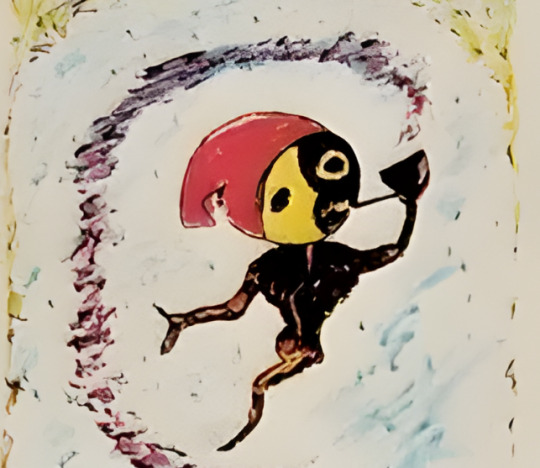
The Saci painted by Newton Cavalcanti to a stamp collection, 1974
Warning: Faith and religion are important real life topics, that tackles the culture and way of life of millions of real life people. It is a cultural expression, and must be respected by all means. Here, we use a video-game ( some times) and other media series only to ignite the flame of learning about the matter, using its art when well depicted, but we do this with all due respect to the cultures we talk here, grounded by real life sources, cultures and people. And i mean this with respect. Hope you all enjoy.
I can finally talk a bit about my home country myths after a brief trip around other countries mythical creatures. The Saci is an extremely popular creature in Brazilian Folklore, and if you are Brazilian i am absolute sure you have encountered its fabulous tales already.
The Saci is (regrettably) not represented in the Megaten game series, as most of characters from my Compendium series. But i want to pop this bubble going forward, and not be exclusively tied to this games, since Mythology is a much more expansive subject, and i like to use Megaten just as a welcoming gate to more casual audiences!
The Saci Pererê is a Brazilian folkloric creature, akin to the trickster ''gnome'' archetype, not considered an evil creature by any means, but very mischievous and a prankster. Normally depicted as a black skinned toddler smoking a pipe, red cap, and some times red clothing. It's most striking feature is his only leg, which he uses to jump around in a surprisingly agile manner. His mischief deeds are many, like he would tie horse's manes, startle them, move objects inside people's homes, etc... His most known power is his control of wind currents. He can summon small sized typhoons, in which the creature can ride on to flee or use to fight if he needs to.
The Saci is hyperactive and fast, always doing something. Some people can interpret this creature as malevolent since its mischief and pranks can cause serious problems, like stealing the breaks of a carriage. However, that's not exactly the truth. The Saci is, almost always portrayed as neutral creture, and it has been since it's inception into the public consciousness. As we can see, some times it can be treated as a little devil, but it's a beloved figure nonetheless.
The name Saci Perere cames from a theorized corruption of the Tupi Guarani words: Caa Cy Perereg, which means ''Jumping Evil Eyes''. That's stated on the book ''Saci Perere: An Inquiry Result''. I was not able to verify it independently because i do not speak Tupi, and i was also unable to find online translators. But, this wording is also verified by the book ''Geography of the Brazilian Myths'' by the legendary Brazilian folklorist Camara Cascudo, so it seems legit. There will be a lot of this book in this subject, because it is such a complete work and a vital piece of research for anyone getting into the topic. [2], [1]
Cascudo does a great scholar work, going as far as giving dis-ambiguity of the Saci from other myths, and even animals that could be related to the legend.
Context: The Tupi Guarani, or just Guarani are the biggest native population living in the territory of Brazil today. They live more from the central region to the south and south-east, relatively far away form the Amazon forest in the northern regions. In general they are polytheists, and today are around 57.000,00 people. [This is sourced by the IBGE, Brazilian Institute of Geography and Statistics]
But, even being a very popular creature in the local folklore, and even transcending the boundaries of its homeland some times, (as we will see ahead) the Saci has a relatively recent history. It's impossible to pinpoint exactly who and how this legend started. But we know it started on the southern and south-eastern most regions of the country, but there's no mention of it on the old fables from native people, which makes scholars think that the Saci is not that old as its relatives of the regional folklore.
A fact that corroborates this assertion is that, besides being a very popular folklore in Brazil, Saci is absent form any mentions to ancient sources, starting to appear more from the 18th century and above. [1]
The name Saci is not stranger to Folklore in the region though. Saci is also the name of a bird, Tapera Naevis, which has a related myth according to the Brazilian National Museum. The Saci bird is treated sometimes like a demon, that can confuse travelers with its singing. Another local legend has that this bird can suck the dead's souls. Al tough both of those claims are backed, i personally did not hear about it until researching for this topic. [1]
This particular bird its said to be seen as a bad omen to this day, in the Amazon region. This is pretty far away from where the folkloric Saci was born, but it seems that a common association with the bird is that it asks for tobacco to its pipe, just like the Saci does. This animal has the habit to sing during night times, so the legend says that it means it wants tobacco. If you actually replies to it, its said the bird will come after your promisse. [1]
This particular bird can also be connected to another folkloric tale, this time from the northern regions of Brazil, a witch called the Matinta-Pereira. This is a particular demonic witch, that can transform itself into the Saci bird, (Tapera Naevis) to get offerings from residents of villages. When her demands are not met, she causes bad things to happen. She also wears a red hat, and her name also bears the ''Perereg'' wording from before. Scholars believe that this is because this bird sometimes jumps in one leg, and has red feathers in their heads, which would also make senses with the Saci! I personally could not find any visual registry about it, but i am sure most of birds some times do this kind of stuff. [1]
The Matinta eventually became a generic name for haunting and supernatural ocurrences in the Northern regions, while the Saci became a thing in the southern regions. The Matinta became more associated with its cursed singings, as the book mentioned before says: ''It trespasses villages with its haunting screams. It will not attack or go after people, thought.'' [1] It kinda resembled me personally of the European Banshee, which also caused misfortune and disasters, and possesses a terrifying cry.
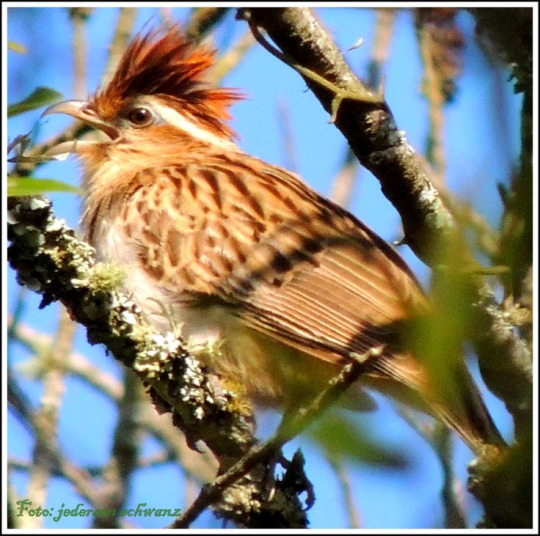

The Saci bird and the Matinta-Pereira witch. (Art i got from Wikipedia, can't find the artist ): )
But this is just one, of the whole ''Birds named as Saci''. There is also the Romococcyx Phasianellus known colloquially as ''Peixe Frito'' (Fried Fish) and inhabits most of Brazilian territory. It has myths around its singing. [1]
If you got interested in this whole rabbit hole of folkloric birds, there's a lot to go on around the world myths! Just some time ago we made an article about the Muh Shubbuu from the Buryati people!
Notably the Saci shares its notoriety and Brazilian legends Pantheon with other similar trickster spirits, like the Caipora and the Curupira. Both are protectors of the nature, both of those are tricksters, and both also asks for tobacco in some legends! Although, the Saci is not a protector of nature, his only goals are to cause mischief. In more recent times, Saci is treated like he's a friend of those two, but this has more of a childish connotation, when teaching about national folklore to children.
The Saci also has spawned some relatives in neighbor countries. In Uruguay there is the Yasi Yatere, which is kind of a gnome with a magical wand. It can shape shift, and it usually kidnaps woman. When its wand is taken, much like the brazilian Saci with its hat, its powers ceases and it becomes weak. It's described in great detail in the book ''Supersticiones y Lendas'', from Juan B Ambrosetti. [1], [3]
In Argentina the Yasi is described mixing the features of its cousins from the region. It is also a dwarf type of gnome, but it's red and also carry a magical wand that protects its powers. They also would kidnap children to play with them, but they would go insane after that. It is also described by Ambrosetti. But also mentioned in a letter of a European missionary called José Guevara. [1]. [3]
Many of these features that the Saci and the Yasi shares comes mostly from European legends, the old archetype of a monster that can be tamed by taking it's belongings. Like the Vouivre from France with its carbuncle. The Saci wears its distinct red hat, that its often taken as the source of its power, so capturing a Saci involves capturing his hat. This could have a Portuguese influence. [1] Theres myths in Portugal, like the so called ''Pesadelo'' which is a creature that when having its hat stolen, could be controlled by the assailant.[1]
-Interesting fact that i have found many sources for this Portuguese myth, and other books mentioning it, but when talking with a friend from Portugal, he could not recognize this specific legend. If you are also Portuguese, and know about it, please let me know!
The 1924 book from F.C Maytzhusen: ''Pigimeos en Leyendas de los Guarnies'' Roughly translated as ''Gnomes in Guarany legends'' tells that the own Gurani people from the region had already its own myths about small magical people living in the woods, which some scholars attribute to an ancient memory of a small stature tribe that potentially lived around. This concept probably mixed very well with the before cited European beliefs, brought by the invaders. [4]
As you can see, it's like the already established lore about native gnome myths got fused with the European equivalents, such as like: The haunting trickster spirits of the woods, small size, agile and mischievous. In the book Geography of Brazilian Myths, the author makes a lot of comparisons to Djins, Imps, Faes, Fairies, and in fact i believe the Saci can absolutely fit in any of those ''races'' of mythic creatures, specially a Djinn or Yokai.
But in that book, the author fixates on the European Kobold being it's main ''ancestry''. The Kobold is like a Goblin, gnome and other whimsical forest creatures like the Brownies, Knockers and Silkies. Kobolds are a bit more versatile than its relatives, being told to live in houses, mining sites, and even boats. The boat ones used to smoke pipe! Kobold are individuals and can be mischievous, haunting and tormenting Humans that don't do their will. Just like their possible Brazilian relatives, the Kobold encounters are not usually fatal.
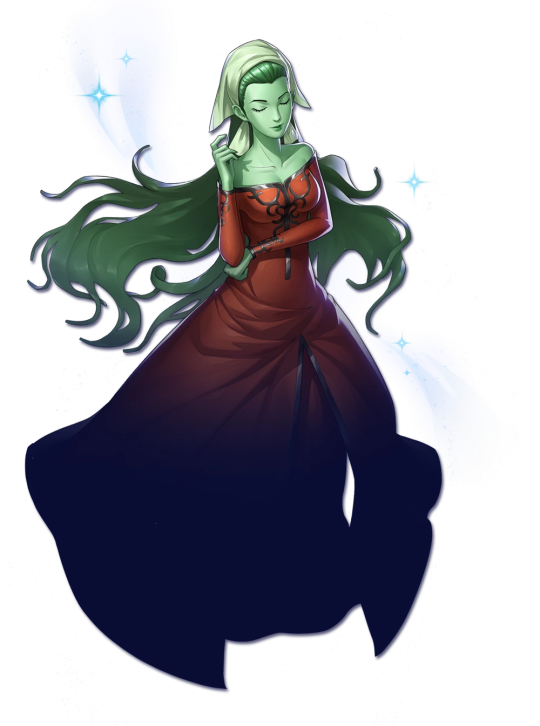

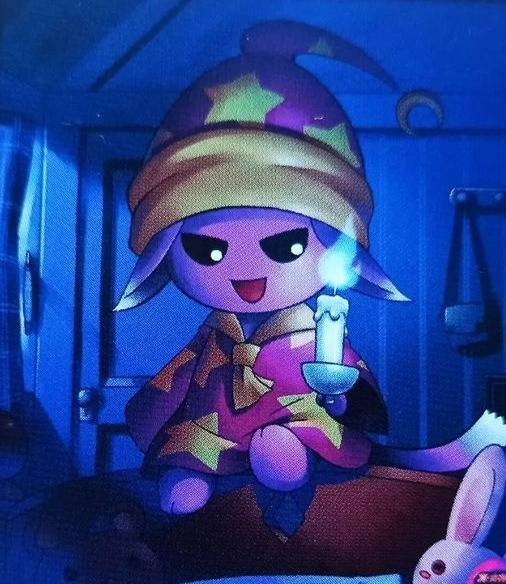

Silky, Knocker, Kobold and Brownies are just some whimsical European fae that can be the common ancestor to the Saci
While some of those European Fae often smoked, the actual academic theory on why the Saci smoked pipe, it's from the native smoking rituals and culture of the Brazilian Native people, such as the Guarany. In the book before mentioned, the native people from Brazil teached the European invaders how to smoke. This was quick considered to be a sin for some European priests and got demonized by some as well, while it spread quickly between their peers. [1]
The Saci being one legged is not something original in mythology. Going back further in time to the legendary book ''Natural History'' from Pliny the Elder, (i really want to come back to this book one day) where he describes the Monopods, humanoid creatures that had just one leg and a giant feet, which they used to cast refreshing shadows on themselves when it was too hot outside. This creatures were before described in the even older book, Indika from Ctesias, and supposedly spotted in India. Just like the Saci, this creature was extremely agile even if just having one leg. They continued to be believed and continuously described well over the middle ages. [1], [5]

Monopod. A rather Silly guy from Nuremberg Chronicle, 1493
There's no consensus on its origins, but some people say that the first people from the Europe seeing Yoga practitioners in India stand in one leg, or have some kind of parasol confused. We will likely never know, but that goes to show one legged humanoid creatures were already talked about much earlier. [1]
In Chile you also had the Ketronamun from the native people there, a small gnome with just one leg, that appear in myths from almost every part of the Pacific South American coast. [1]
But there were also one legged deities around, take Tezcatlipoca from the Mexica (Aztecs) for instance. Being the god of moon and the stars, and one of the most important beings in the Mexica pantheon, he lost its leg fighting Cipactli. It was also related to the nocturnal wind, another connection with the Saci. But there is no scholar belief that the two were actually connected, they just shared a lot of similarities. [1]

T ezcatlipoca misses his leg, or foot in many depictions!
But How the Saci was actually Born?
As we discussed the Saci Pererê was not cataloged by the first European Invaders of the 16th century. In truth, there are a lot of myths and tales that were properly archived by them, but the Saci is nowhere to be seen. So, scholars deduct the Saci was not that old, being actually born and popularized around the 17th century. [1] But the Saci would just gain character and personality around the 19th century.
The legend much probably, spread by word of mouth from south to north, while it would slowly absorbing local and foreign elements during its trip. From the regional mythical creatures like the Curupira, he inherited the ability to confuse and mislead people. From Caipora he inherited the haunting whistles and its relationship with horses. Its only leg could be from the Bird myths, and also inherited from European folklore as well. Its own red hat also coming from there. [1]
The red hat sometimes its a sign of supernatural entities in Europe. The name ''The One With The Red Hat'' was an euphemism for Satan himself and other devils in Portugal. The Saci some times is treated like a devil, in the Book ''Saci: An Inquiry Result'' at the page 83, there's a tale about the Saci appearing with a sulfur scent, just like demons would normally do. [2]
The Revival and the Controversy of Monteiro Lobato
When we talk about the Saci in Brazil, the elephant in the room is always Monteiro Lobato, an author from the 20th century. Without a doubt, his work was one of the most prolific and known authors if its time, and also dedicated a lot of his work to disseminate national Folklore. There was just one big problem: He was a terrible person. Lobato was a racist, aligned with the United Statian KKK, (yes) and generally treated people, specially black people, very poorly. So, if that was a text oriented only for Brazilians, i'd completely ignore his name, and would focus on the texts. But, for the sake of education of foreign readers, i had to mention him.
In 1917, this (awful) individual published an inquiry in one of the biggest newspapers of the country, searching for personal and regional tales about the Saci, which he planned to catalog and archive. The idea was to protect the national Folklore, since he would argument that we should focus on our own mythology, rather than importing everything from other countries. While the Saci had the ancestry of European Myth, it was a 100% modern Brazilian born legend. This kind of thought is pretty impressive from a racist dipshit, but ok.
Although Lobato did had the idea of collecting tales, they were all brought from other people, regular people, which i prefer to credit. With this rather than him. They published the book ''Saci: An Inquiry Result''. This book would be very important for the Saci lore, because it ended up skyrocketing its dim popularity, making sure he would survive for more centuries.
A funny trivia about this book, is that at the time of its publishing, the newspaper asked its sponsors to make ads using the Saci. Which had some pretty weird art that i rather not show. Thank you Monteiro Lobato for creating our capitalist version of the Dictionaire Infernal, very cool.
[EDIT] Lobato is also the creator of the work ''Sítio do Pica Pau Amarelo'' or roughly translated as Spot of the Yellow Woodpecker. I ended up not talking about it, but this is by far his most famous work that featured the Saci Pererê as one of the main character, as many other folkloric Brazilian entities. This work is often credited as many children's first contact with the Saci, and other folk Brazilian tales. This particular series is about a farm owned by Benta, an elderly woman that lived alone in the countryside. Her friend Nastácia lives along, and is famous for her dishes. She often gets visits of her nephew Lucia, which has the nickname Narizinho. She brings along her doll Emillia, which ends up gaining life and becomes a sort of tomboyish sidekick. They both live adventures along her friends and folkloric creatures.
Much regarded as the ''Brazilian Wizard of Oz'' this work was so popular it got adapted into several comic books and live action shows. The most popular of which aired during the 2000s from 2001 to 2007, and i as a kid often watched it. My favorite character had to be Emilia. (She will be present in the compendium, or a lesser post soon enough)
Al tough, due to Lobato awful nature as a person, the series is often pointed out as racist and problematic, being also written in the early 20th century it was filled with problems, which made a lot of people that grew up with this work depressed by those details. Luckily this is one of the rare occasions where there is an active effort from scholars and fans alike, to separate Sitio's influence on Brazilian culture and Folklore, from the awful person that was Lobato. The book is now on Public Domain, and each new iteration of the story deletes more and more problematic points, and as more decades went by, it gets more safe to consume and mixed with the Brazilian folklore, leaving the author in a sweet side note.
That said, not everybody is ok with this approach as well, and prefer to just abandon the literary work entirely. Which i honestly can't blame them for...

One of the latest iterations of Sitio do Pica Pau Amarelo is a cartoon, produced during the 2010s. Here are Emilia and Lucia.
But, as the 20th century went by and more people went in contact with the Saci tales, now widespread, the once regional myth started to gain the world, and became a symbol of the country culture. For instance, in the 70s and 80s the Saci would be featured in the Japanese anime: Akuma Kun, from the legendary author Shigeru Mizuki, which i already covered many times here. Mizuki is an old acquaintance of us theologians, because he was not only a mangaka, but also a devoted scholar of over the world mythologies. Its studies some times ended up in Brazil, and that's how he got the Saci.
You may know this author from the famous Ge Ge Ge no Kitaro series. Mizuki made some mistakes, but he was one of the most important folklorists of its time, helping to protect and disseminate the folklore of his country. According the author Michael Dylan Foster, in the book ''The book of Yokai'' Mizuki was influenced by folklorists as such Yanagita Kunio (we already mentioned him here as well, for the Obayrion post!) And thanks to Mizuki, most post war Japanese people were thinking of his works, when thinking about Yokai.
But back to the Saci, he was a recurring character in the Akuma Kun manga. The series was about a boy that could control mythical creatures from around the world. Since Akuma Kun got a lot of sequels and reboots, we are talking about Saishinban Akuma Kun, from 1988. There, the Saci makes an appearance! The looks is very faithful, but the hat isn't red, and in the animation the character would have two legs, rather than the only leg always associated with it. Still, he controlled the winds and was very mischievous just like in its home country!


The Saci in Akuma Kun Manga vs Anime
Mizuki's iteration of the Saci also just loses its powers when people take out his pipe, which differs from our regular version, where the hat does that. Besides this fact, Mizuki takes the artistic freedom to make the creature liking Football, which i particularly find funny but a bit stereotypical, and some people did not liked it. Overall, i thought it as a great representation!
Akuma Kun will get a new Anime in 2023. Lets hope that our Brazilian whimsicall friend makes an appearance.
There is much talk on how Mizuki found about the Saci Pererê, and the contact of Japanese with Brazilian folklore. I already explored that on my text on the Pokémon Whimsicott as well. However, the Brazilian Folklore in my opinion resonates very well with Japanese Folklore, so much that a lot of other Japanese artists that came in contact with it ended up using it as inspiration as well. A very known example is from the animator Ype Nakashima, that much probably had contact with Mizuki. The Saci was a character in one of Ype's most beloved works, the animation Piconze.
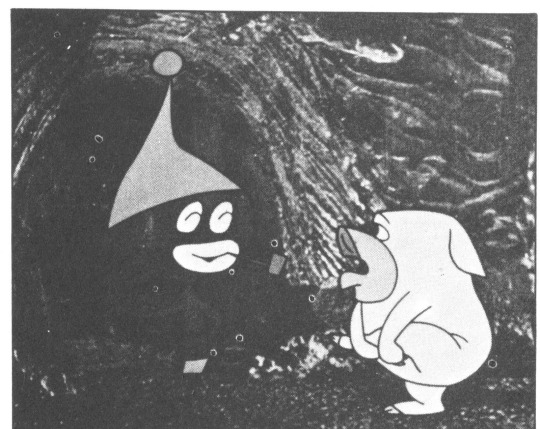
Although the exagerated details in the Saci, that can be seen as problematic nowadays, this depiction is a product of its time, and i do not agree with it. It's here for the purpose of education.
While the Saci is not from Japan, we can see that it would get along very well with other Yokai, which ends up making it kind of popular with Japanese audiences. Other Brazilian Mythical creatures were also explored by foreigners like the Cuca, Caipora, (which appeared in the Demi Kids series of games, by the way!) The Curupira, and many others!
The Saci vs the Halloween a National Symbol
The Saci Pererê got the status of a national symbol. And as such, it was often used as a counter point to foreign interference in Brazilian culture. Since its rebirth in the 20th century, in an attempt to retrieve its legacy, the creature is often held as a protector of Brazilian culture.
As such, in 2003 it was proposed by Brazilian politics that the Saci should have a national holiday, and it should be commemorated in October 31st, in opposition to the growing Halloween culture around Brazil. The argument was that this was a foreign holiday, not from our country, and we should celebrate the Saci as a symbol of patriotism.
Notoriously, the beef between the Saci and Jack O'Lantern was commemorated in a song, from the 2013 parody metal album ''Metal Folklore'', sang by the Brazilian metal singer Bruno Sutter, acting as his parody Persona the Detonator. The album was pretty well received and brought attention to the concept again, with the song called ''Saci.'' which is a critic to United States imperialism and its forced influence on Brazilian culture. Bruno brought along the famous Punk Rock singer João Gordo to this track, which is a celebrated artist in the country, who even ended up in some Nirvana gigs, back in the 1990s.
I personally got to know Bruno during a concert, and even watched him perform live. The dude is amazing, and you should give it a listen!
You can listen to this particular song on Spotify!
''October 31st is the Saci day!
Do not fool yourself my friend
Halloween is american, which is far away from Brazil
Trick or treat is your fucking mother!
Saci is the red cape warrior!
Saci is a mischievous boy!
The Pumpkin is already shitting itself
Don't fuck with Brazilian Folklore!'' -Some Lyrics from the song
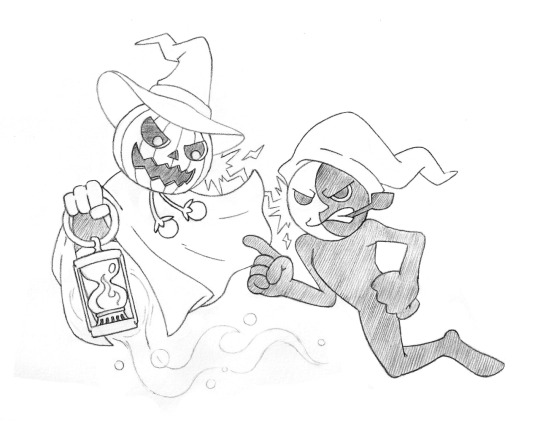
This amazing artwork was provided by my great friend @atmaflare! Here we see the Saci having an argument with Jack O'Lantern, probably saying to him to stay away from his turf.
The comedic and critic nature of the song made it pretty popular at the time, and this canonically beef between the two creatures became somewhat common here. Still, both are dates are celebrated without any major incident! The Saci Day is not a way to attack the culture of Halloween, but to bring attention to our own folklore.
Inside Brazil, Saci is also a major character of the amazing Netflix series ''Invisible City'' which is all about Brazilian Folklore, and supernatural occurrences in a life of a police officer in modern times. Give it a watch!
On Personal Notes
So, in this case the Saci comes from my home country and naturally i grew up with his tales of mischief and supernatural occurrences. In this sense, i have much more of a personal connection to my topic of study for this text, and so i can have my own verdict to it. It's natural for kids here to have contact with this mythical character. Or at least, it was when i was a kid in the early 2000s.
When i was little, the Saci was a particular mythological being that i feared. It was not that he was dangerous in a real sense of the way, but i rather not find it alone in the woods, or be bullied by him.
Still there was a grain of fascination by his figure, because there was the possibility to actually win against the Saci, taking his hat and making him do as our biding. And most of time, his mischief ended up as funny for kids.
Nowadays the Saci is still regarded as one of the most beloved folkloric tales of Brazil, inspiring newer generations of folklorists to protect and share the culture that they belong and grew up with, such as myself. For this reason, the Saci will always stay in the Brazilian collective consciousnesses, not only because of its supernatural powers, its haunting abilities surviving the current age, but also as a symbol of our own home in this planet.
As Camara Cascudo said in his book:
''Today the Devil that is inseparable from tales, from countryman conversations. Vague, haunting, unexpected, malicious, humorous (...) Now, diluted in the memory of those who does not have the spiritual age to fear it anymore.''
Sources and Bibliography:
1- Camara Cascudo: Geografia dos Mitos Brasileiros (Geography of Brazilian Myths)
2- Saci: Resultado de um Inquérito, Monteiro Lobato (Saci: An Inquiry Result)
3- Supersticiones y Lendas'', Juan B Ambrosetti.
4- Pigimeos en Leyendas de los Guarnies, F.C Maytzhusen
5- Natural History, Pliny the Elder
6- The Book of Yokai, Michael Dylan Foster (small Citation)
#blazescompendiumentry#brazilian folklore#folclore brasileiro#saci perere#jack o lantern#pyro jack#megaten#folclore#long post#m#mythology#brazilian mythology#shin megami tensei 2#blazescompendium
34 notes
·
View notes
Text
Commissioned my friend to do some art of me as a Devil Summoner with Chiro!

This art was made by my great friend @burnheelde!
Her commissions are open, and i honestly love her style. I am glad i befriended such great people in the Megaten community since i started here and on Instagram. She is an amazing person, as much as an artist.
Chiro is, as no surprise, my favorite demon and she made him so cute. Not to mention the cool COMP as a detail! The more i look, the more i fall in love with it!
In case her @ won't work, here is her blog: https://www.tumblr.com/burnheelde?source=share
Again, her comms are open, so i highly recommend you guys to go take a look at her art!
13 notes
·
View notes